Evidence-Based Practice in Health Care: Reinforcing Safe Practice
VerifiedAdded on 2023/01/18
|16
|5251
|78
AI Summary
This essay presents a critical examination of how evidence-based practice reinforces safe practice in health care and differentiates between different types of evidence used in nursing practice. The research topic focuses on the benefits of specialist nurses for people diagnosed with Chronic Obstructive Pulmonary Disease (COPD) and their impact on reducing hospital admissions. The essay provides evidence for the association between specialist nurses and health outcomes of COPD patients through a range of literature. The research question formulated using the PICO framework explores the effect of specialist nursing care on the rate of hospital admission among COPD patients. The methodology includes a literature search strategy and data extraction using specific frameworks.
Contribute Materials
Your contribution can guide someone’s learning journey. Share your
documents today.
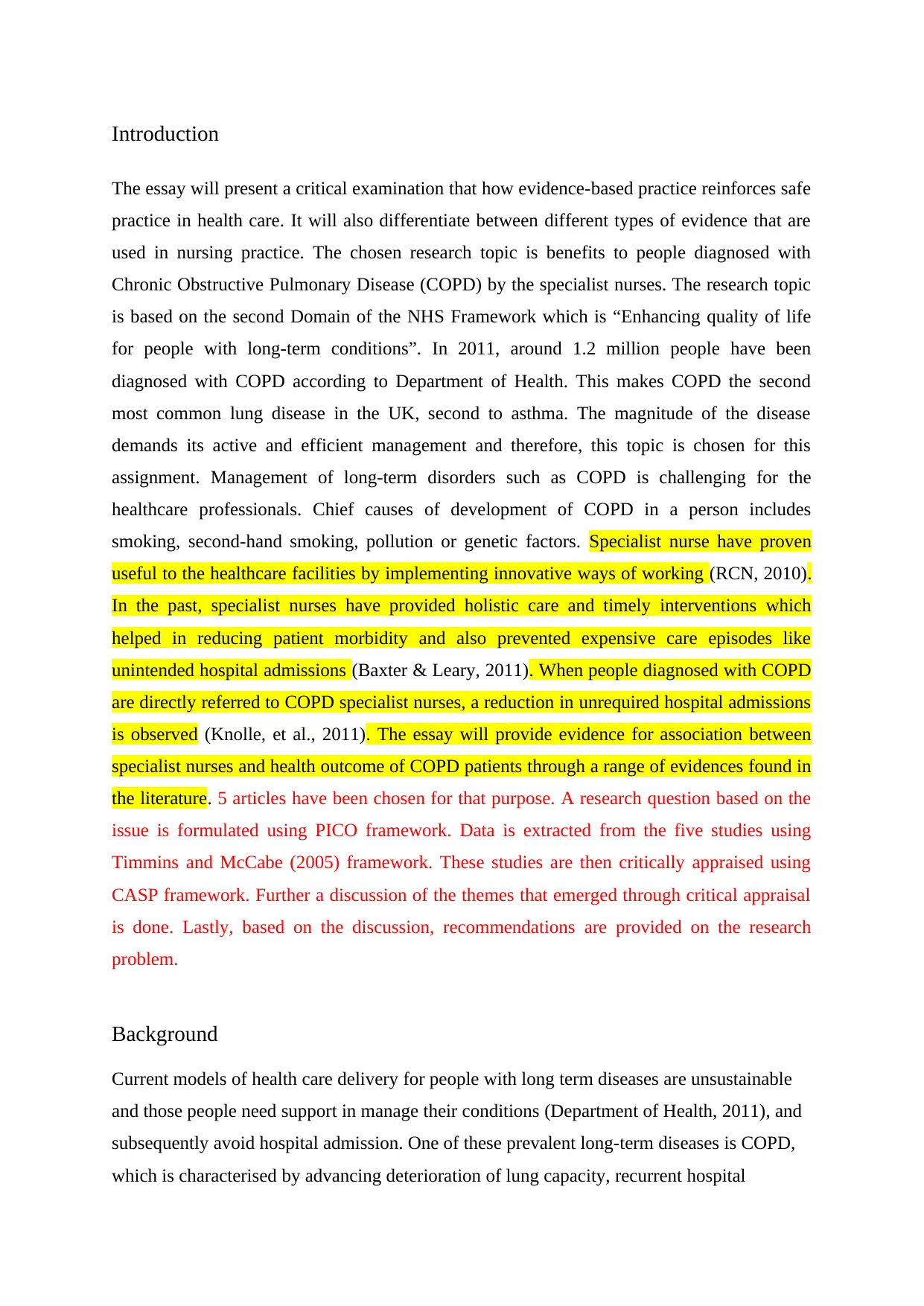
Introduction
The essay will present a critical examination that how evidence-based practice reinforces safe
practice in health care. It will also differentiate between different types of evidence that are
used in nursing practice. The chosen research topic is benefits to people diagnosed with
Chronic Obstructive Pulmonary Disease (COPD) by the specialist nurses. The research topic
is based on the second Domain of the NHS Framework which is “Enhancing quality of life
for people with long-term conditions”. In 2011, around 1.2 million people have been
diagnosed with COPD according to Department of Health. This makes COPD the second
most common lung disease in the UK, second to asthma. The magnitude of the disease
demands its active and efficient management and therefore, this topic is chosen for this
assignment. Management of long-term disorders such as COPD is challenging for the
healthcare professionals. Chief causes of development of COPD in a person includes
smoking, second-hand smoking, pollution or genetic factors. Specialist nurse have proven
useful to the healthcare facilities by implementing innovative ways of working (RCN, 2010).
In the past, specialist nurses have provided holistic care and timely interventions which
helped in reducing patient morbidity and also prevented expensive care episodes like
unintended hospital admissions (Baxter & Leary, 2011). When people diagnosed with COPD
are directly referred to COPD specialist nurses, a reduction in unrequired hospital admissions
is observed (Knolle, et al., 2011). The essay will provide evidence for association between
specialist nurses and health outcome of COPD patients through a range of evidences found in
the literature. 5 articles have been chosen for that purpose. A research question based on the
issue is formulated using PICO framework. Data is extracted from the five studies using
Timmins and McCabe (2005) framework. These studies are then critically appraised using
CASP framework. Further a discussion of the themes that emerged through critical appraisal
is done. Lastly, based on the discussion, recommendations are provided on the research
problem.
Background
Current models of health care delivery for people with long term diseases are unsustainable
and those people need support in manage their conditions (Department of Health, 2011), and
subsequently avoid hospital admission. One of these prevalent long-term diseases is COPD,
which is characterised by advancing deterioration of lung capacity, recurrent hospital
The essay will present a critical examination that how evidence-based practice reinforces safe
practice in health care. It will also differentiate between different types of evidence that are
used in nursing practice. The chosen research topic is benefits to people diagnosed with
Chronic Obstructive Pulmonary Disease (COPD) by the specialist nurses. The research topic
is based on the second Domain of the NHS Framework which is “Enhancing quality of life
for people with long-term conditions”. In 2011, around 1.2 million people have been
diagnosed with COPD according to Department of Health. This makes COPD the second
most common lung disease in the UK, second to asthma. The magnitude of the disease
demands its active and efficient management and therefore, this topic is chosen for this
assignment. Management of long-term disorders such as COPD is challenging for the
healthcare professionals. Chief causes of development of COPD in a person includes
smoking, second-hand smoking, pollution or genetic factors. Specialist nurse have proven
useful to the healthcare facilities by implementing innovative ways of working (RCN, 2010).
In the past, specialist nurses have provided holistic care and timely interventions which
helped in reducing patient morbidity and also prevented expensive care episodes like
unintended hospital admissions (Baxter & Leary, 2011). When people diagnosed with COPD
are directly referred to COPD specialist nurses, a reduction in unrequired hospital admissions
is observed (Knolle, et al., 2011). The essay will provide evidence for association between
specialist nurses and health outcome of COPD patients through a range of evidences found in
the literature. 5 articles have been chosen for that purpose. A research question based on the
issue is formulated using PICO framework. Data is extracted from the five studies using
Timmins and McCabe (2005) framework. These studies are then critically appraised using
CASP framework. Further a discussion of the themes that emerged through critical appraisal
is done. Lastly, based on the discussion, recommendations are provided on the research
problem.
Background
Current models of health care delivery for people with long term diseases are unsustainable
and those people need support in manage their conditions (Department of Health, 2011), and
subsequently avoid hospital admission. One of these prevalent long-term diseases is COPD,
which is characterised by advancing deterioration of lung capacity, recurrent hospital
Secure Best Marks with AI Grader
Need help grading? Try our AI Grader for instant feedback on your assignments.
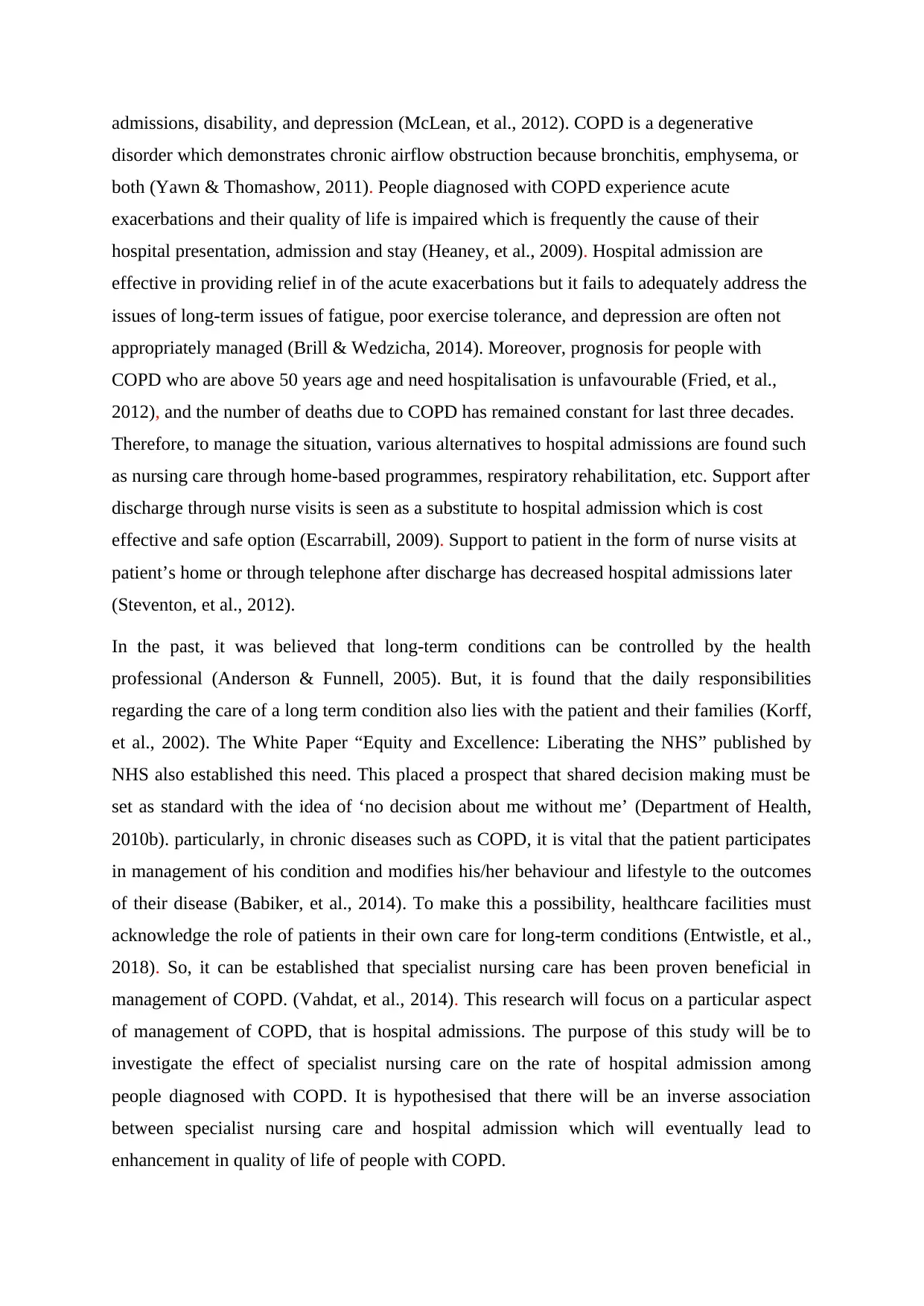
admissions, disability, and depression (McLean, et al., 2012). COPD is a degenerative
disorder which demonstrates chronic airflow obstruction because bronchitis, emphysema, or
both (Yawn & Thomashow, 2011). People diagnosed with COPD experience acute
exacerbations and their quality of life is impaired which is frequently the cause of their
hospital presentation, admission and stay (Heaney, et al., 2009). Hospital admission are
effective in providing relief in of the acute exacerbations but it fails to adequately address the
issues of long-term issues of fatigue, poor exercise tolerance, and depression are often not
appropriately managed (Brill & Wedzicha, 2014). Moreover, prognosis for people with
COPD who are above 50 years age and need hospitalisation is unfavourable (Fried, et al.,
2012), and the number of deaths due to COPD has remained constant for last three decades.
Therefore, to manage the situation, various alternatives to hospital admissions are found such
as nursing care through home-based programmes, respiratory rehabilitation, etc. Support after
discharge through nurse visits is seen as a substitute to hospital admission which is cost
effective and safe option (Escarrabill, 2009). Support to patient in the form of nurse visits at
patient’s home or through telephone after discharge has decreased hospital admissions later
(Steventon, et al., 2012).
In the past, it was believed that long-term conditions can be controlled by the health
professional (Anderson & Funnell, 2005). But, it is found that the daily responsibilities
regarding the care of a long term condition also lies with the patient and their families (Korff,
et al., 2002). The White Paper “Equity and Excellence: Liberating the NHS” published by
NHS also established this need. This placed a prospect that shared decision making must be
set as standard with the idea of ‘no decision about me without me’ (Department of Health,
2010b). particularly, in chronic diseases such as COPD, it is vital that the patient participates
in management of his condition and modifies his/her behaviour and lifestyle to the outcomes
of their disease (Babiker, et al., 2014). To make this a possibility, healthcare facilities must
acknowledge the role of patients in their own care for long-term conditions (Entwistle, et al.,
2018). So, it can be established that specialist nursing care has been proven beneficial in
management of COPD. (Vahdat, et al., 2014). This research will focus on a particular aspect
of management of COPD, that is hospital admissions. The purpose of this study will be to
investigate the effect of specialist nursing care on the rate of hospital admission among
people diagnosed with COPD. It is hypothesised that there will be an inverse association
between specialist nursing care and hospital admission which will eventually lead to
enhancement in quality of life of people with COPD.
disorder which demonstrates chronic airflow obstruction because bronchitis, emphysema, or
both (Yawn & Thomashow, 2011). People diagnosed with COPD experience acute
exacerbations and their quality of life is impaired which is frequently the cause of their
hospital presentation, admission and stay (Heaney, et al., 2009). Hospital admission are
effective in providing relief in of the acute exacerbations but it fails to adequately address the
issues of long-term issues of fatigue, poor exercise tolerance, and depression are often not
appropriately managed (Brill & Wedzicha, 2014). Moreover, prognosis for people with
COPD who are above 50 years age and need hospitalisation is unfavourable (Fried, et al.,
2012), and the number of deaths due to COPD has remained constant for last three decades.
Therefore, to manage the situation, various alternatives to hospital admissions are found such
as nursing care through home-based programmes, respiratory rehabilitation, etc. Support after
discharge through nurse visits is seen as a substitute to hospital admission which is cost
effective and safe option (Escarrabill, 2009). Support to patient in the form of nurse visits at
patient’s home or through telephone after discharge has decreased hospital admissions later
(Steventon, et al., 2012).
In the past, it was believed that long-term conditions can be controlled by the health
professional (Anderson & Funnell, 2005). But, it is found that the daily responsibilities
regarding the care of a long term condition also lies with the patient and their families (Korff,
et al., 2002). The White Paper “Equity and Excellence: Liberating the NHS” published by
NHS also established this need. This placed a prospect that shared decision making must be
set as standard with the idea of ‘no decision about me without me’ (Department of Health,
2010b). particularly, in chronic diseases such as COPD, it is vital that the patient participates
in management of his condition and modifies his/her behaviour and lifestyle to the outcomes
of their disease (Babiker, et al., 2014). To make this a possibility, healthcare facilities must
acknowledge the role of patients in their own care for long-term conditions (Entwistle, et al.,
2018). So, it can be established that specialist nursing care has been proven beneficial in
management of COPD. (Vahdat, et al., 2014). This research will focus on a particular aspect
of management of COPD, that is hospital admissions. The purpose of this study will be to
investigate the effect of specialist nursing care on the rate of hospital admission among
people diagnosed with COPD. It is hypothesised that there will be an inverse association
between specialist nursing care and hospital admission which will eventually lead to
enhancement in quality of life of people with COPD.
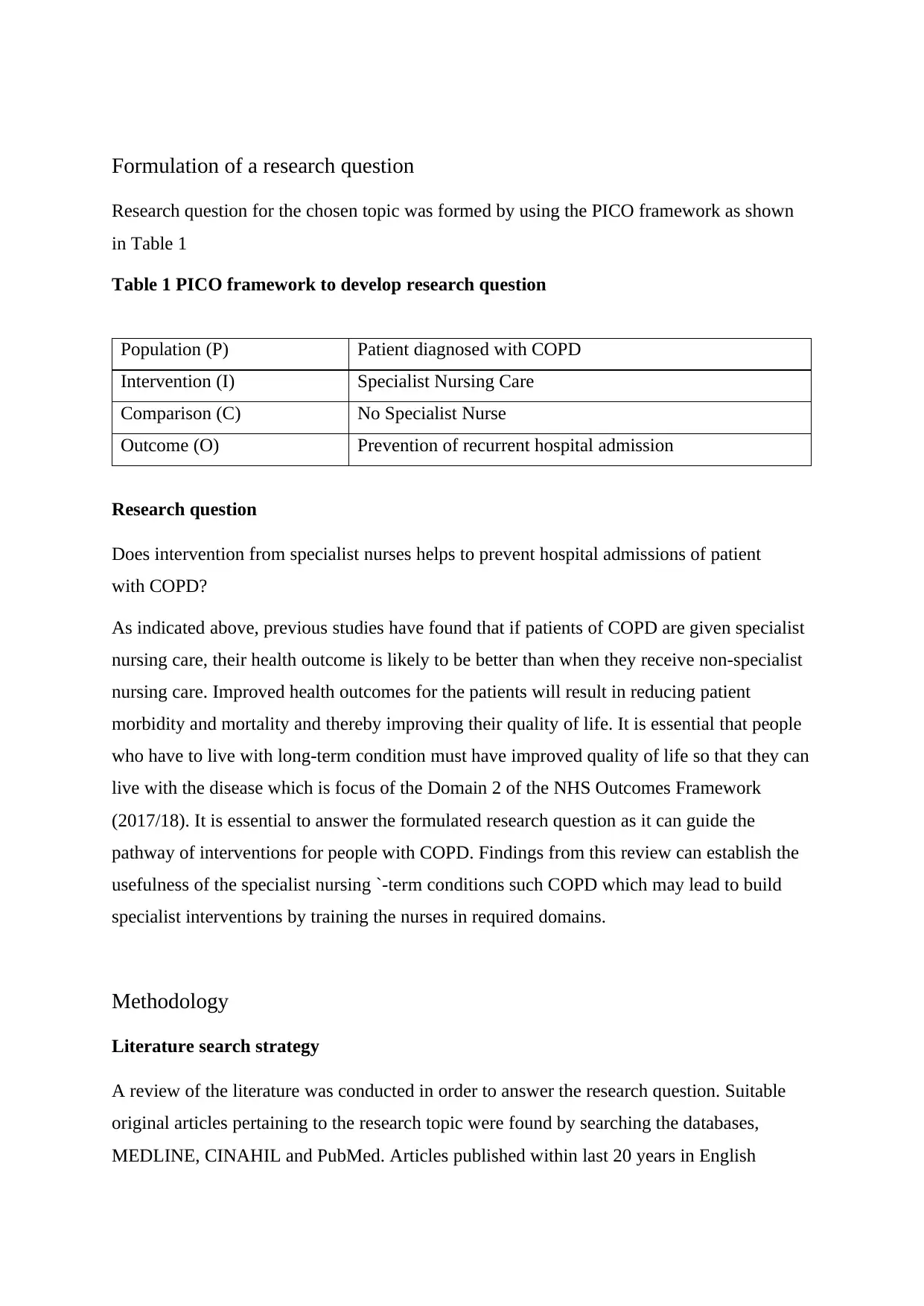
Formulation of a research question
Research question for the chosen topic was formed by using the PICO framework as shown
in Table 1
Table 1 PICO framework to develop research question
Population (P) Patient diagnosed with COPD
Intervention (I) Specialist Nursing Care
Comparison (C) No Specialist Nurse
Outcome (O) Prevention of recurrent hospital admission
Research question
Does intervention from specialist nurses helps to prevent hospital admissions of patient
with COPD?
As indicated above, previous studies have found that if patients of COPD are given specialist
nursing care, their health outcome is likely to be better than when they receive non-specialist
nursing care. Improved health outcomes for the patients will result in reducing patient
morbidity and mortality and thereby improving their quality of life. It is essential that people
who have to live with long-term condition must have improved quality of life so that they can
live with the disease which is focus of the Domain 2 of the NHS Outcomes Framework
(2017/18). It is essential to answer the formulated research question as it can guide the
pathway of interventions for people with COPD. Findings from this review can establish the
usefulness of the specialist nursing `-term conditions such COPD which may lead to build
specialist interventions by training the nurses in required domains.
Methodology
Literature search strategy
A review of the literature was conducted in order to answer the research question. Suitable
original articles pertaining to the research topic were found by searching the databases,
MEDLINE, CINAHIL and PubMed. Articles published within last 20 years in English
Research question for the chosen topic was formed by using the PICO framework as shown
in Table 1
Table 1 PICO framework to develop research question
Population (P) Patient diagnosed with COPD
Intervention (I) Specialist Nursing Care
Comparison (C) No Specialist Nurse
Outcome (O) Prevention of recurrent hospital admission
Research question
Does intervention from specialist nurses helps to prevent hospital admissions of patient
with COPD?
As indicated above, previous studies have found that if patients of COPD are given specialist
nursing care, their health outcome is likely to be better than when they receive non-specialist
nursing care. Improved health outcomes for the patients will result in reducing patient
morbidity and mortality and thereby improving their quality of life. It is essential that people
who have to live with long-term condition must have improved quality of life so that they can
live with the disease which is focus of the Domain 2 of the NHS Outcomes Framework
(2017/18). It is essential to answer the formulated research question as it can guide the
pathway of interventions for people with COPD. Findings from this review can establish the
usefulness of the specialist nursing `-term conditions such COPD which may lead to build
specialist interventions by training the nurses in required domains.
Methodology
Literature search strategy
A review of the literature was conducted in order to answer the research question. Suitable
original articles pertaining to the research topic were found by searching the databases,
MEDLINE, CINAHIL and PubMed. Articles published within last 20 years in English
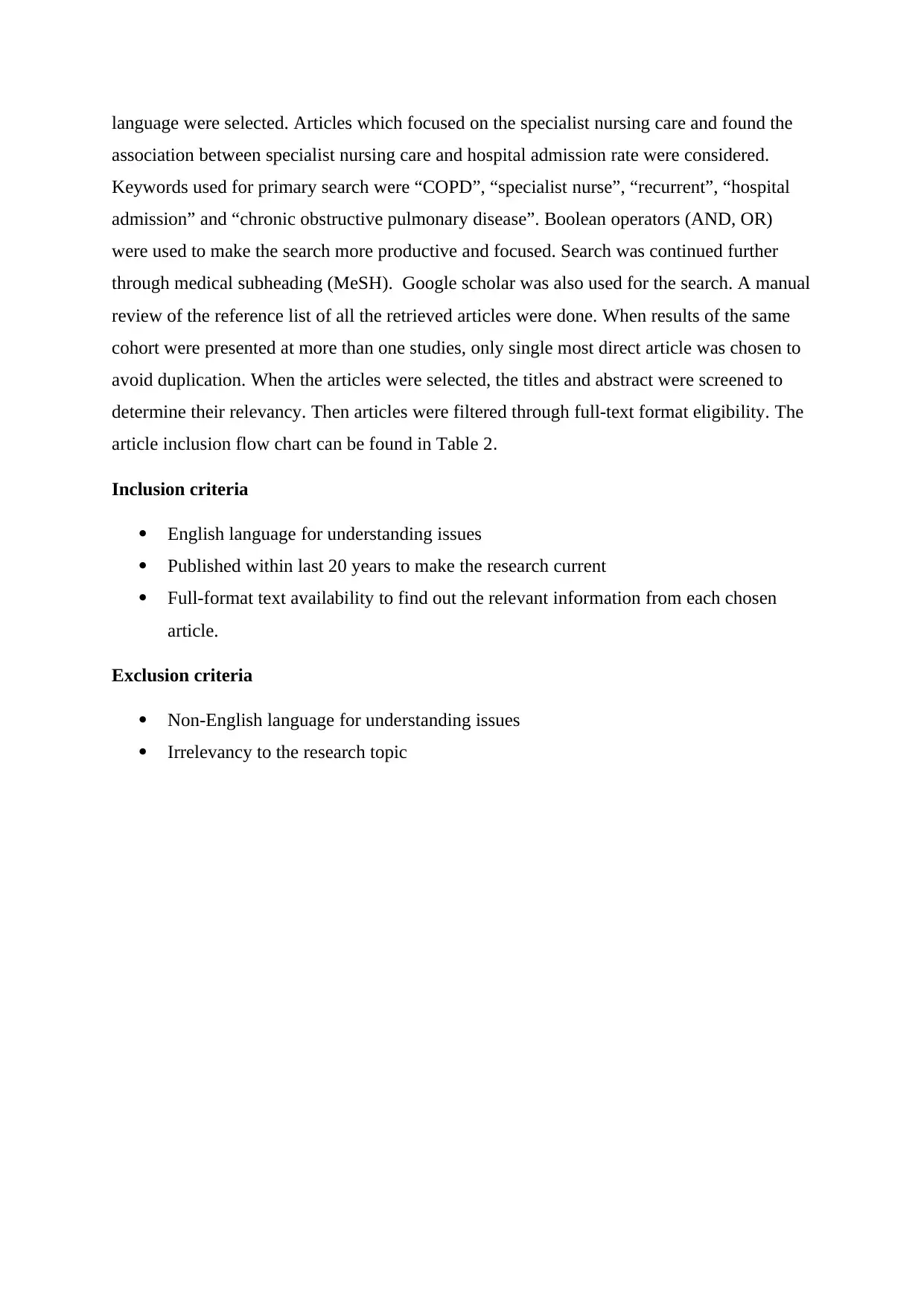
language were selected. Articles which focused on the specialist nursing care and found the
association between specialist nursing care and hospital admission rate were considered.
Keywords used for primary search were “COPD”, “specialist nurse”, “recurrent”, “hospital
admission” and “chronic obstructive pulmonary disease”. Boolean operators (AND, OR)
were used to make the search more productive and focused. Search was continued further
through medical subheading (MeSH). Google scholar was also used for the search. A manual
review of the reference list of all the retrieved articles were done. When results of the same
cohort were presented at more than one studies, only single most direct article was chosen to
avoid duplication. When the articles were selected, the titles and abstract were screened to
determine their relevancy. Then articles were filtered through full-text format eligibility. The
article inclusion flow chart can be found in Table 2.
Inclusion criteria
English language for understanding issues
Published within last 20 years to make the research current
Full-format text availability to find out the relevant information from each chosen
article.
Exclusion criteria
Non-English language for understanding issues
Irrelevancy to the research topic
association between specialist nursing care and hospital admission rate were considered.
Keywords used for primary search were “COPD”, “specialist nurse”, “recurrent”, “hospital
admission” and “chronic obstructive pulmonary disease”. Boolean operators (AND, OR)
were used to make the search more productive and focused. Search was continued further
through medical subheading (MeSH). Google scholar was also used for the search. A manual
review of the reference list of all the retrieved articles were done. When results of the same
cohort were presented at more than one studies, only single most direct article was chosen to
avoid duplication. When the articles were selected, the titles and abstract were screened to
determine their relevancy. Then articles were filtered through full-text format eligibility. The
article inclusion flow chart can be found in Table 2.
Inclusion criteria
English language for understanding issues
Published within last 20 years to make the research current
Full-format text availability to find out the relevant information from each chosen
article.
Exclusion criteria
Non-English language for understanding issues
Irrelevancy to the research topic
Secure Best Marks with AI Grader
Need help grading? Try our AI Grader for instant feedback on your assignments.
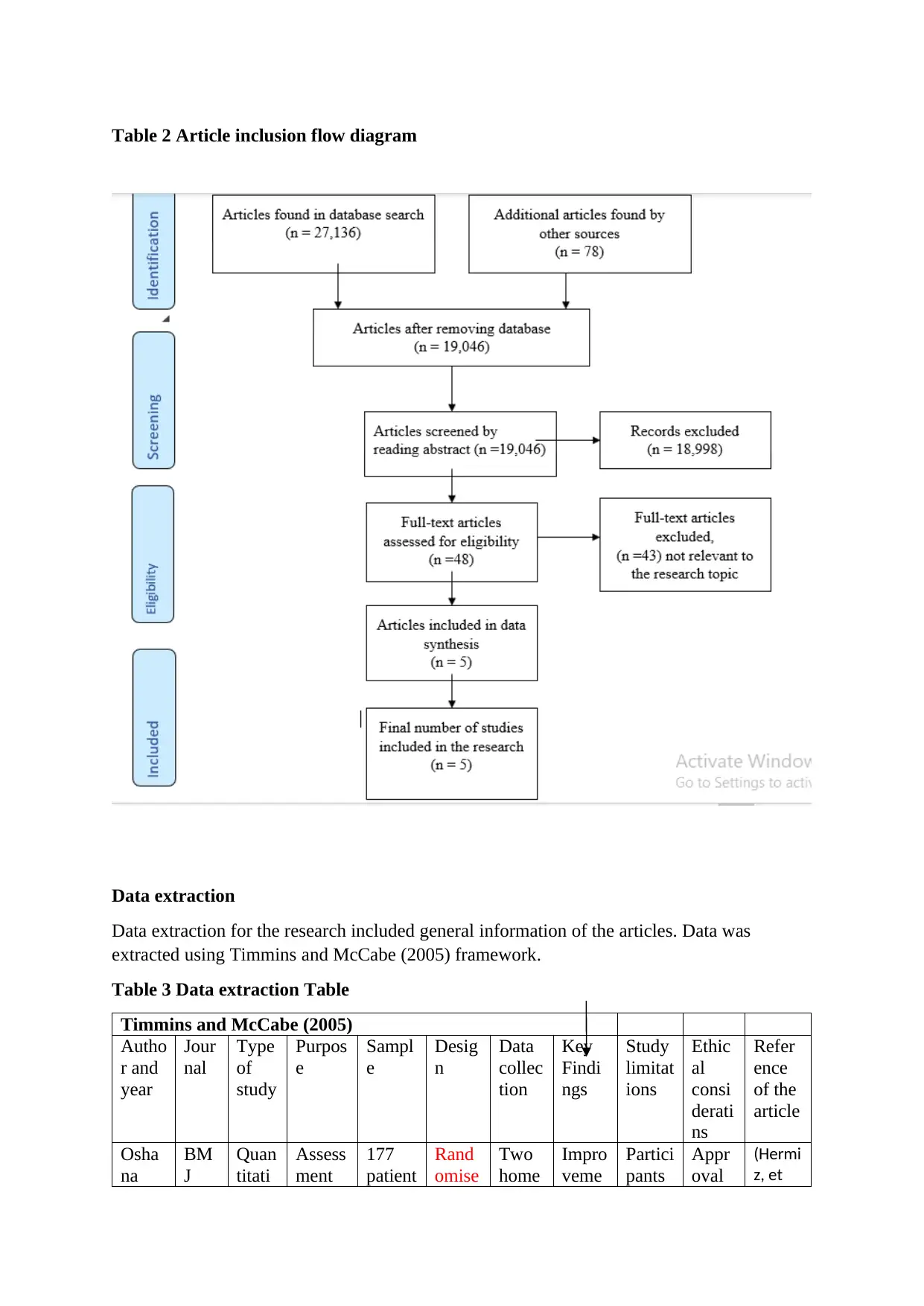
Table 2 Article inclusion flow diagram
Data extraction
Data extraction for the research included general information of the articles. Data was
extracted using Timmins and McCabe (2005) framework.
Table 3 Data extraction Table
Timmins and McCabe (2005)
Autho
r and
year
Jour
nal
Type
of
study
Purpos
e
Sampl
e
Desig
n
Data
collec
tion
Key
Findi
ngs
Study
limitat
ions
Ethic
al
consi
derati
ns
Refer
ence
of the
article
Osha
na
BM
J
Quan
titati
Assess
ment
177
patient
Rand
omise
Two
home
Impro
veme
Partici
pants
Appr
oval
(Hermi
z, et
Data extraction
Data extraction for the research included general information of the articles. Data was
extracted using Timmins and McCabe (2005) framework.
Table 3 Data extraction Table
Timmins and McCabe (2005)
Autho
r and
year
Jour
nal
Type
of
study
Purpos
e
Sampl
e
Desig
n
Data
collec
tion
Key
Findi
ngs
Study
limitat
ions
Ethic
al
consi
derati
ns
Refer
ence
of the
article
Osha
na
BM
J
Quan
titati
Assess
ment
177
patient
Rand
omise
Two
home
Impro
veme
Partici
pants
Appr
oval
(Hermi
z, et
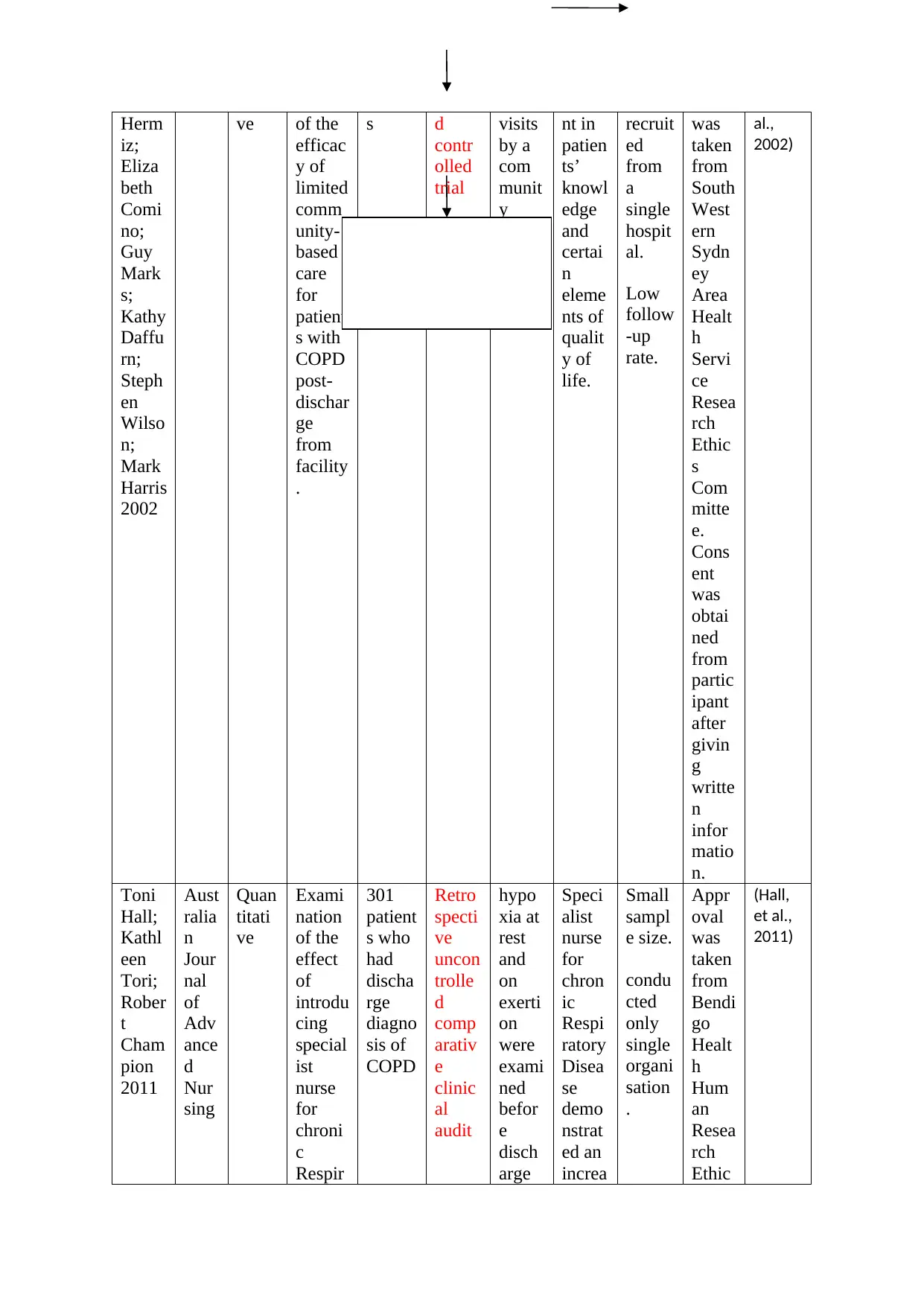
Herm
iz;
Eliza
beth
Comi
no;
Guy
Mark
s;
Kathy
Daffu
rn;
Steph
en
Wilso
n;
Mark
Harris
2002
ve of the
efficac
y of
limited
comm
unity-
based
care
for
patient
s with
COPD
post-
dischar
ge
from
facility
.
s d
contr
olled
trial
visits
by a
com
munit
y
nurse.
nt in
patien
ts’
knowl
edge
and
certai
n
eleme
nts of
qualit
y of
life.
recruit
ed
from
a
single
hospit
al.
Low
follow
-up
rate.
was
taken
from
South
West
ern
Sydn
ey
Area
Healt
h
Servi
ce
Resea
rch
Ethic
s
Com
mitte
e.
Cons
ent
was
obtai
ned
from
partic
ipant
after
givin
g
writte
n
infor
matio
n.
al.,
2002)
Toni
Hall;
Kathl
een
Tori;
Rober
t
Cham
pion
2011
Aust
ralia
n
Jour
nal
of
Adv
ance
d
Nur
sing
Quan
titati
ve
Exami
nation
of the
effect
of
introdu
cing
special
ist
nurse
for
chroni
c
Respir
301
patient
s who
had
discha
rge
diagno
sis of
COPD
Retro
specti
ve
uncon
trolle
d
comp
arativ
e
clinic
al
audit
hypo
xia at
rest
and
on
exerti
on
were
exami
ned
befor
e
disch
arge
Speci
alist
nurse
for
chron
ic
Respi
ratory
Disea
se
demo
nstrat
ed an
increa
Small
sampl
e size.
condu
cted
only
single
organi
sation
.
Appr
oval
was
taken
from
Bendi
go
Healt
h
Hum
an
Resea
rch
Ethic
(Hall,
et al.,
2011)
iz;
Eliza
beth
Comi
no;
Guy
Mark
s;
Kathy
Daffu
rn;
Steph
en
Wilso
n;
Mark
Harris
2002
ve of the
efficac
y of
limited
comm
unity-
based
care
for
patient
s with
COPD
post-
dischar
ge
from
facility
.
s d
contr
olled
trial
visits
by a
com
munit
y
nurse.
nt in
patien
ts’
knowl
edge
and
certai
n
eleme
nts of
qualit
y of
life.
recruit
ed
from
a
single
hospit
al.
Low
follow
-up
rate.
was
taken
from
South
West
ern
Sydn
ey
Area
Healt
h
Servi
ce
Resea
rch
Ethic
s
Com
mitte
e.
Cons
ent
was
obtai
ned
from
partic
ipant
after
givin
g
writte
n
infor
matio
n.
al.,
2002)
Toni
Hall;
Kathl
een
Tori;
Rober
t
Cham
pion
2011
Aust
ralia
n
Jour
nal
of
Adv
ance
d
Nur
sing
Quan
titati
ve
Exami
nation
of the
effect
of
introdu
cing
special
ist
nurse
for
chroni
c
Respir
301
patient
s who
had
discha
rge
diagno
sis of
COPD
Retro
specti
ve
uncon
trolle
d
comp
arativ
e
clinic
al
audit
hypo
xia at
rest
and
on
exerti
on
were
exami
ned
befor
e
disch
arge
Speci
alist
nurse
for
chron
ic
Respi
ratory
Disea
se
demo
nstrat
ed an
increa
Small
sampl
e size.
condu
cted
only
single
organi
sation
.
Appr
oval
was
taken
from
Bendi
go
Healt
h
Hum
an
Resea
rch
Ethic
(Hall,
et al.,
2011)
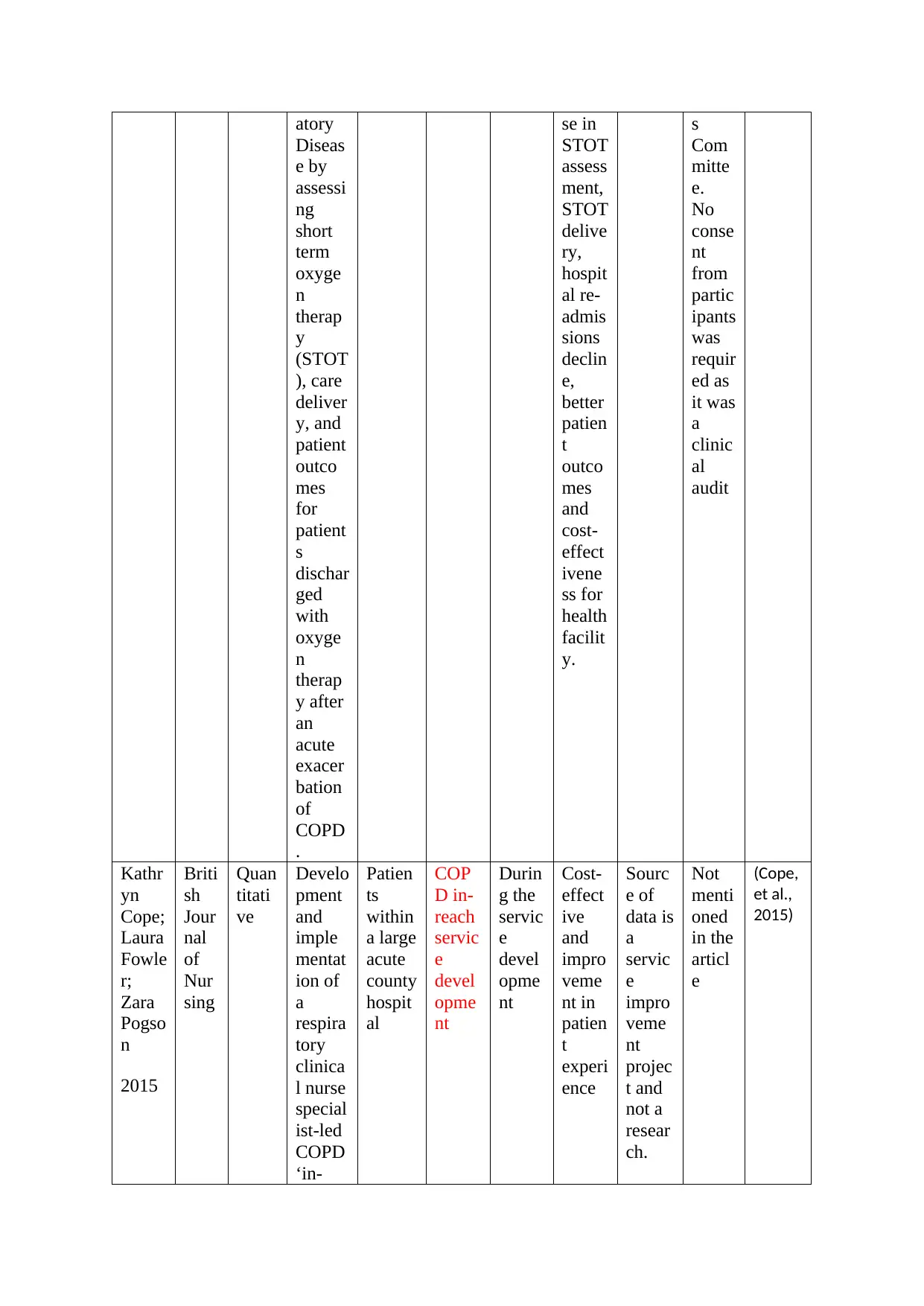
atory
Diseas
e by
assessi
ng
short
term
oxyge
n
therap
y
(STOT
), care
deliver
y, and
patient
outco
mes
for
patient
s
dischar
ged
with
oxyge
n
therap
y after
an
acute
exacer
bation
of
COPD
.
se in
STOT
assess
ment,
STOT
delive
ry,
hospit
al re-
admis
sions
declin
e,
better
patien
t
outco
mes
and
cost-
effect
ivene
ss for
health
facilit
y.
s
Com
mitte
e.
No
conse
nt
from
partic
ipants
was
requir
ed as
it was
a
clinic
al
audit
Kathr
yn
Cope;
Laura
Fowle
r;
Zara
Pogso
n
2015
Briti
sh
Jour
nal
of
Nur
sing
Quan
titati
ve
Develo
pment
and
imple
mentat
ion of
a
respira
tory
clinica
l nurse
special
ist-led
COPD
‘in-
Patien
ts
within
a large
acute
county
hospit
al
COP
D in-
reach
servic
e
devel
opme
nt
Durin
g the
servic
e
devel
opme
nt
Cost-
effect
ive
and
impro
veme
nt in
patien
t
experi
ence
Sourc
e of
data is
a
servic
e
impro
veme
nt
projec
t and
not a
resear
ch.
Not
menti
oned
in the
articl
e
(Cope,
et al.,
2015)
Diseas
e by
assessi
ng
short
term
oxyge
n
therap
y
(STOT
), care
deliver
y, and
patient
outco
mes
for
patient
s
dischar
ged
with
oxyge
n
therap
y after
an
acute
exacer
bation
of
COPD
.
se in
STOT
assess
ment,
STOT
delive
ry,
hospit
al re-
admis
sions
declin
e,
better
patien
t
outco
mes
and
cost-
effect
ivene
ss for
health
facilit
y.
s
Com
mitte
e.
No
conse
nt
from
partic
ipants
was
requir
ed as
it was
a
clinic
al
audit
Kathr
yn
Cope;
Laura
Fowle
r;
Zara
Pogso
n
2015
Briti
sh
Jour
nal
of
Nur
sing
Quan
titati
ve
Develo
pment
and
imple
mentat
ion of
a
respira
tory
clinica
l nurse
special
ist-led
COPD
‘in-
Patien
ts
within
a large
acute
county
hospit
al
COP
D in-
reach
servic
e
devel
opme
nt
Durin
g the
servic
e
devel
opme
nt
Cost-
effect
ive
and
impro
veme
nt in
patien
t
experi
ence
Sourc
e of
data is
a
servic
e
impro
veme
nt
projec
t and
not a
resear
ch.
Not
menti
oned
in the
articl
e
(Cope,
et al.,
2015)
Paraphrase This Document
Need a fresh take? Get an instant paraphrase of this document with our AI Paraphraser
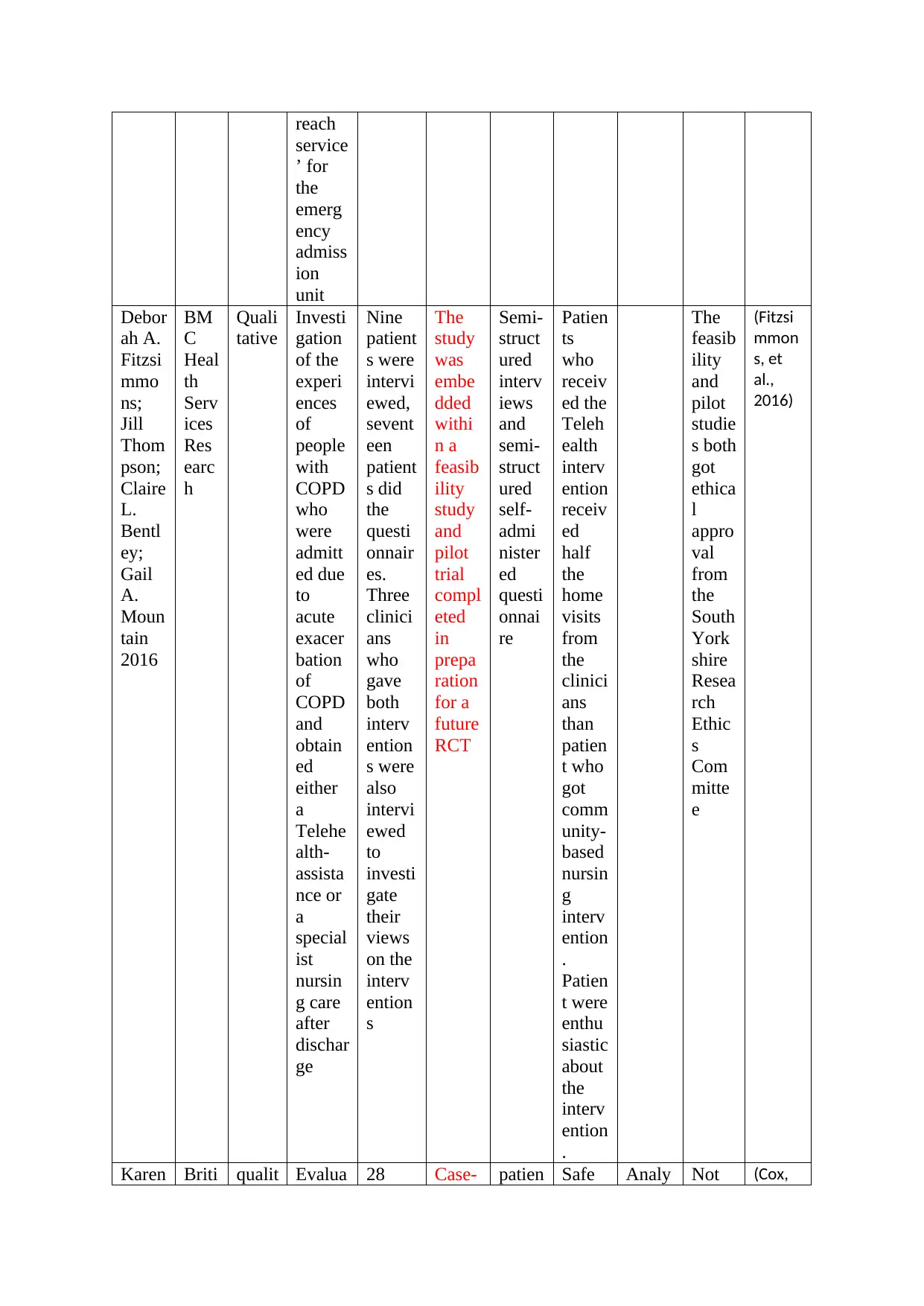
reach
service
’ for
the
emerg
ency
admiss
ion
unit
Debor
ah A.
Fitzsi
mmo
ns;
Jill
Thom
pson;
Claire
L.
Bentl
ey;
Gail
A.
Moun
tain
2016
BM
C
Heal
th
Serv
ices
Res
earc
h
Quali
tative
Investi
gation
of the
experi
ences
of
people
with
COPD
who
were
admitt
ed due
to
acute
exacer
bation
of
COPD
and
obtain
ed
either
a
Telehe
alth-
assista
nce or
a
special
ist
nursin
g care
after
dischar
ge
Nine
patient
s were
intervi
ewed,
sevent
een
patient
s did
the
questi
onnair
es.
Three
clinici
ans
who
gave
both
interv
ention
s were
also
intervi
ewed
to
investi
gate
their
views
on the
interv
ention
s
The
study
was
embe
dded
withi
n a
feasib
ility
study
and
pilot
trial
compl
eted
in
prepa
ration
for a
future
RCT
Semi-
struct
ured
interv
iews
and
semi-
struct
ured
self-
admi
nister
ed
questi
onnai
re
Patien
ts
who
receiv
ed the
Teleh
ealth
interv
ention
receiv
ed
half
the
home
visits
from
the
clinici
ans
than
patien
t who
got
comm
unity-
based
nursin
g
interv
ention
.
Patien
t were
enthu
siastic
about
the
interv
ention
.
The
feasib
ility
and
pilot
studie
s both
got
ethica
l
appro
val
from
the
South
York
shire
Resea
rch
Ethic
s
Com
mitte
e
(Fitzsi
mmon
s, et
al.,
2016)
Karen Briti qualit Evalua 28 Case- patien Safe Analy Not (Cox,
service
’ for
the
emerg
ency
admiss
ion
unit
Debor
ah A.
Fitzsi
mmo
ns;
Jill
Thom
pson;
Claire
L.
Bentl
ey;
Gail
A.
Moun
tain
2016
BM
C
Heal
th
Serv
ices
Res
earc
h
Quali
tative
Investi
gation
of the
experi
ences
of
people
with
COPD
who
were
admitt
ed due
to
acute
exacer
bation
of
COPD
and
obtain
ed
either
a
Telehe
alth-
assista
nce or
a
special
ist
nursin
g care
after
dischar
ge
Nine
patient
s were
intervi
ewed,
sevent
een
patient
s did
the
questi
onnair
es.
Three
clinici
ans
who
gave
both
interv
ention
s were
also
intervi
ewed
to
investi
gate
their
views
on the
interv
ention
s
The
study
was
embe
dded
withi
n a
feasib
ility
study
and
pilot
trial
compl
eted
in
prepa
ration
for a
future
RCT
Semi-
struct
ured
interv
iews
and
semi-
struct
ured
self-
admi
nister
ed
questi
onnai
re
Patien
ts
who
receiv
ed the
Teleh
ealth
interv
ention
receiv
ed
half
the
home
visits
from
the
clinici
ans
than
patien
t who
got
comm
unity-
based
nursin
g
interv
ention
.
Patien
t were
enthu
siastic
about
the
interv
ention
.
The
feasib
ility
and
pilot
studie
s both
got
ethica
l
appro
val
from
the
South
York
shire
Resea
rch
Ethic
s
Com
mitte
e
(Fitzsi
mmon
s, et
al.,
2016)
Karen Briti qualit Evalua 28 Case- patien Safe Analy Not (Cox,
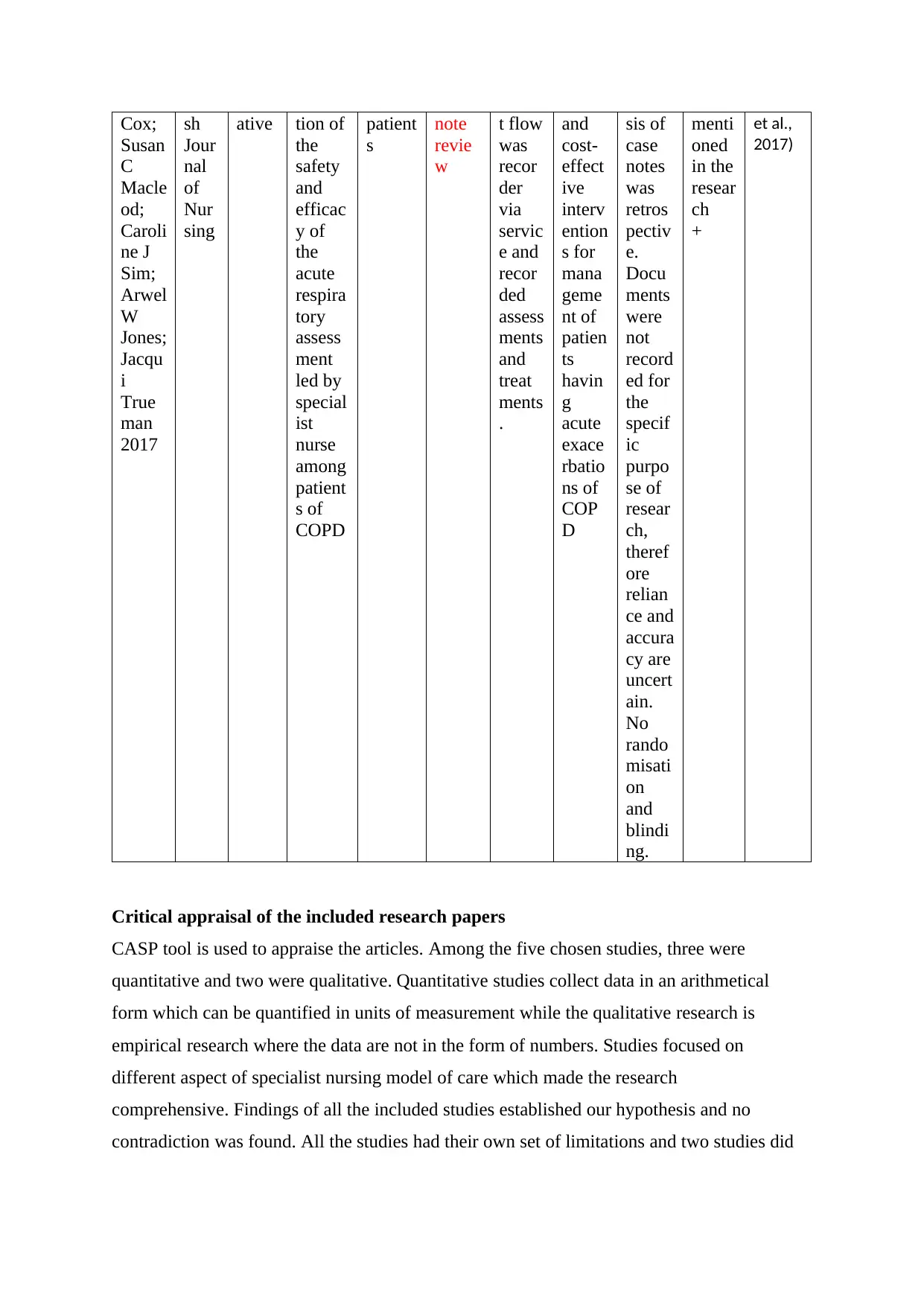
Cox;
Susan
C
Macle
od;
Caroli
ne J
Sim;
Arwel
W
Jones;
Jacqu
i
True
man
2017
sh
Jour
nal
of
Nur
sing
ative tion of
the
safety
and
efficac
y of
the
acute
respira
tory
assess
ment
led by
special
ist
nurse
among
patient
s of
COPD
patient
s
note
revie
w
t flow
was
recor
der
via
servic
e and
recor
ded
assess
ments
and
treat
ments
.
and
cost-
effect
ive
interv
ention
s for
mana
geme
nt of
patien
ts
havin
g
acute
exace
rbatio
ns of
COP
D
sis of
case
notes
was
retros
pectiv
e.
Docu
ments
were
not
record
ed for
the
specif
ic
purpo
se of
resear
ch,
theref
ore
relian
ce and
accura
cy are
uncert
ain.
No
rando
misati
on
and
blindi
ng.
menti
oned
in the
resear
ch
+
et al.,
2017)
Critical appraisal of the included research papers
CASP tool is used to appraise the articles. Among the five chosen studies, three were
quantitative and two were qualitative. Quantitative studies collect data in an arithmetical
form which can be quantified in units of measurement while the qualitative research is
empirical research where the data are not in the form of numbers. Studies focused on
different aspect of specialist nursing model of care which made the research
comprehensive. Findings of all the included studies established our hypothesis and no
contradiction was found. All the studies had their own set of limitations and two studies did
Susan
C
Macle
od;
Caroli
ne J
Sim;
Arwel
W
Jones;
Jacqu
i
True
man
2017
sh
Jour
nal
of
Nur
sing
ative tion of
the
safety
and
efficac
y of
the
acute
respira
tory
assess
ment
led by
special
ist
nurse
among
patient
s of
COPD
patient
s
note
revie
w
t flow
was
recor
der
via
servic
e and
recor
ded
assess
ments
and
treat
ments
.
and
cost-
effect
ive
interv
ention
s for
mana
geme
nt of
patien
ts
havin
g
acute
exace
rbatio
ns of
COP
D
sis of
case
notes
was
retros
pectiv
e.
Docu
ments
were
not
record
ed for
the
specif
ic
purpo
se of
resear
ch,
theref
ore
relian
ce and
accura
cy are
uncert
ain.
No
rando
misati
on
and
blindi
ng.
menti
oned
in the
resear
ch
+
et al.,
2017)
Critical appraisal of the included research papers
CASP tool is used to appraise the articles. Among the five chosen studies, three were
quantitative and two were qualitative. Quantitative studies collect data in an arithmetical
form which can be quantified in units of measurement while the qualitative research is
empirical research where the data are not in the form of numbers. Studies focused on
different aspect of specialist nursing model of care which made the research
comprehensive. Findings of all the included studies established our hypothesis and no
contradiction was found. All the studies had their own set of limitations and two studies did
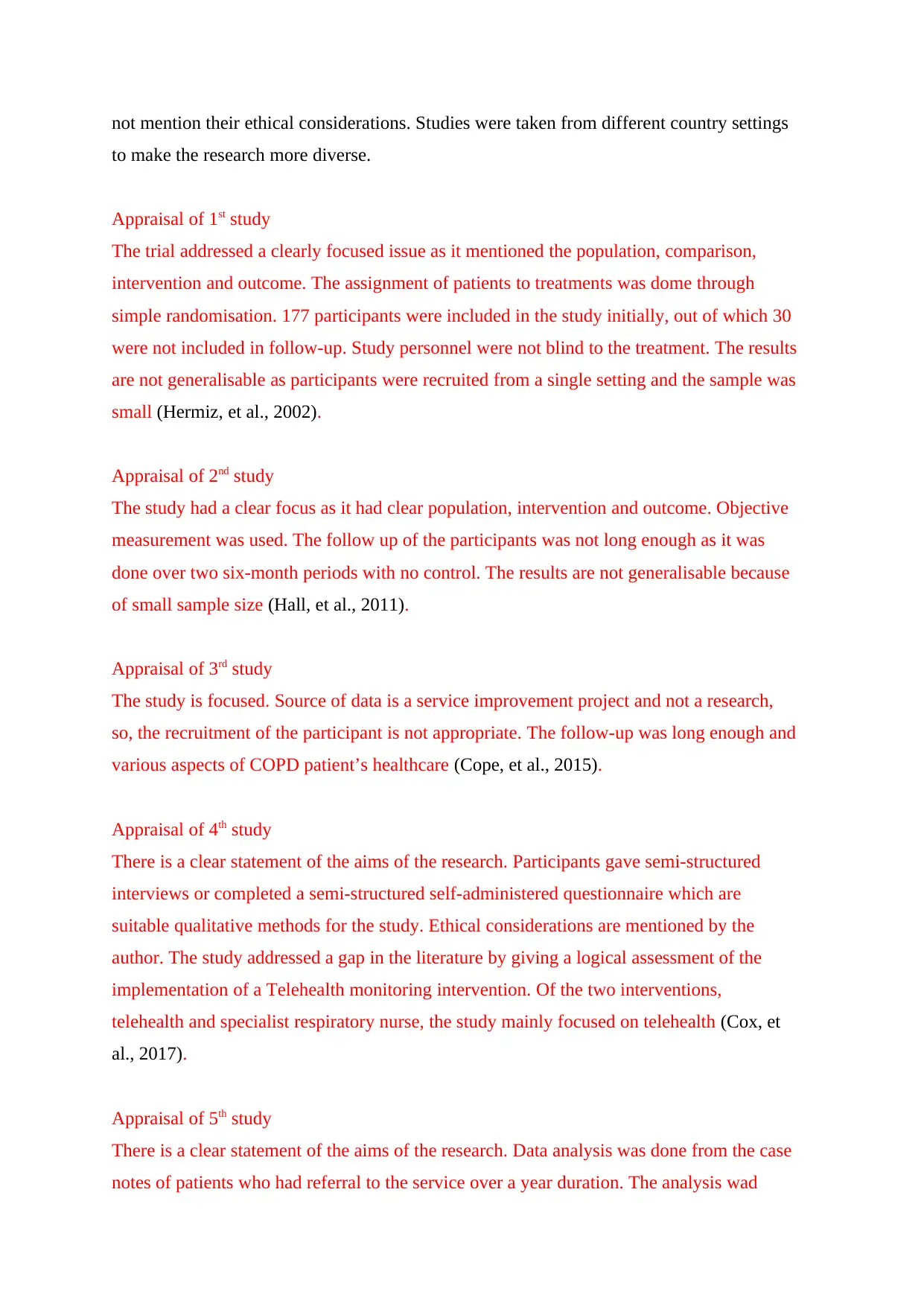
not mention their ethical considerations. Studies were taken from different country settings
to make the research more diverse.
Appraisal of 1st study
The trial addressed a clearly focused issue as it mentioned the population, comparison,
intervention and outcome. The assignment of patients to treatments was dome through
simple randomisation. 177 participants were included in the study initially, out of which 30
were not included in follow-up. Study personnel were not blind to the treatment. The results
are not generalisable as participants were recruited from a single setting and the sample was
small (Hermiz, et al., 2002).
Appraisal of 2nd study
The study had a clear focus as it had clear population, intervention and outcome. Objective
measurement was used. The follow up of the participants was not long enough as it was
done over two six-month periods with no control. The results are not generalisable because
of small sample size (Hall, et al., 2011).
Appraisal of 3rd study
The study is focused. Source of data is a service improvement project and not a research,
so, the recruitment of the participant is not appropriate. The follow-up was long enough and
various aspects of COPD patient’s healthcare (Cope, et al., 2015).
Appraisal of 4th study
There is a clear statement of the aims of the research. Participants gave semi-structured
interviews or completed a semi-structured self-administered questionnaire which are
suitable qualitative methods for the study. Ethical considerations are mentioned by the
author. The study addressed a gap in the literature by giving a logical assessment of the
implementation of a Telehealth monitoring intervention. Of the two interventions,
telehealth and specialist respiratory nurse, the study mainly focused on telehealth (Cox, et
al., 2017).
Appraisal of 5th study
There is a clear statement of the aims of the research. Data analysis was done from the case
notes of patients who had referral to the service over a year duration. The analysis wad
to make the research more diverse.
Appraisal of 1st study
The trial addressed a clearly focused issue as it mentioned the population, comparison,
intervention and outcome. The assignment of patients to treatments was dome through
simple randomisation. 177 participants were included in the study initially, out of which 30
were not included in follow-up. Study personnel were not blind to the treatment. The results
are not generalisable as participants were recruited from a single setting and the sample was
small (Hermiz, et al., 2002).
Appraisal of 2nd study
The study had a clear focus as it had clear population, intervention and outcome. Objective
measurement was used. The follow up of the participants was not long enough as it was
done over two six-month periods with no control. The results are not generalisable because
of small sample size (Hall, et al., 2011).
Appraisal of 3rd study
The study is focused. Source of data is a service improvement project and not a research,
so, the recruitment of the participant is not appropriate. The follow-up was long enough and
various aspects of COPD patient’s healthcare (Cope, et al., 2015).
Appraisal of 4th study
There is a clear statement of the aims of the research. Participants gave semi-structured
interviews or completed a semi-structured self-administered questionnaire which are
suitable qualitative methods for the study. Ethical considerations are mentioned by the
author. The study addressed a gap in the literature by giving a logical assessment of the
implementation of a Telehealth monitoring intervention. Of the two interventions,
telehealth and specialist respiratory nurse, the study mainly focused on telehealth (Cox, et
al., 2017).
Appraisal of 5th study
There is a clear statement of the aims of the research. Data analysis was done from the case
notes of patients who had referral to the service over a year duration. The analysis wad
Secure Best Marks with AI Grader
Need help grading? Try our AI Grader for instant feedback on your assignments.
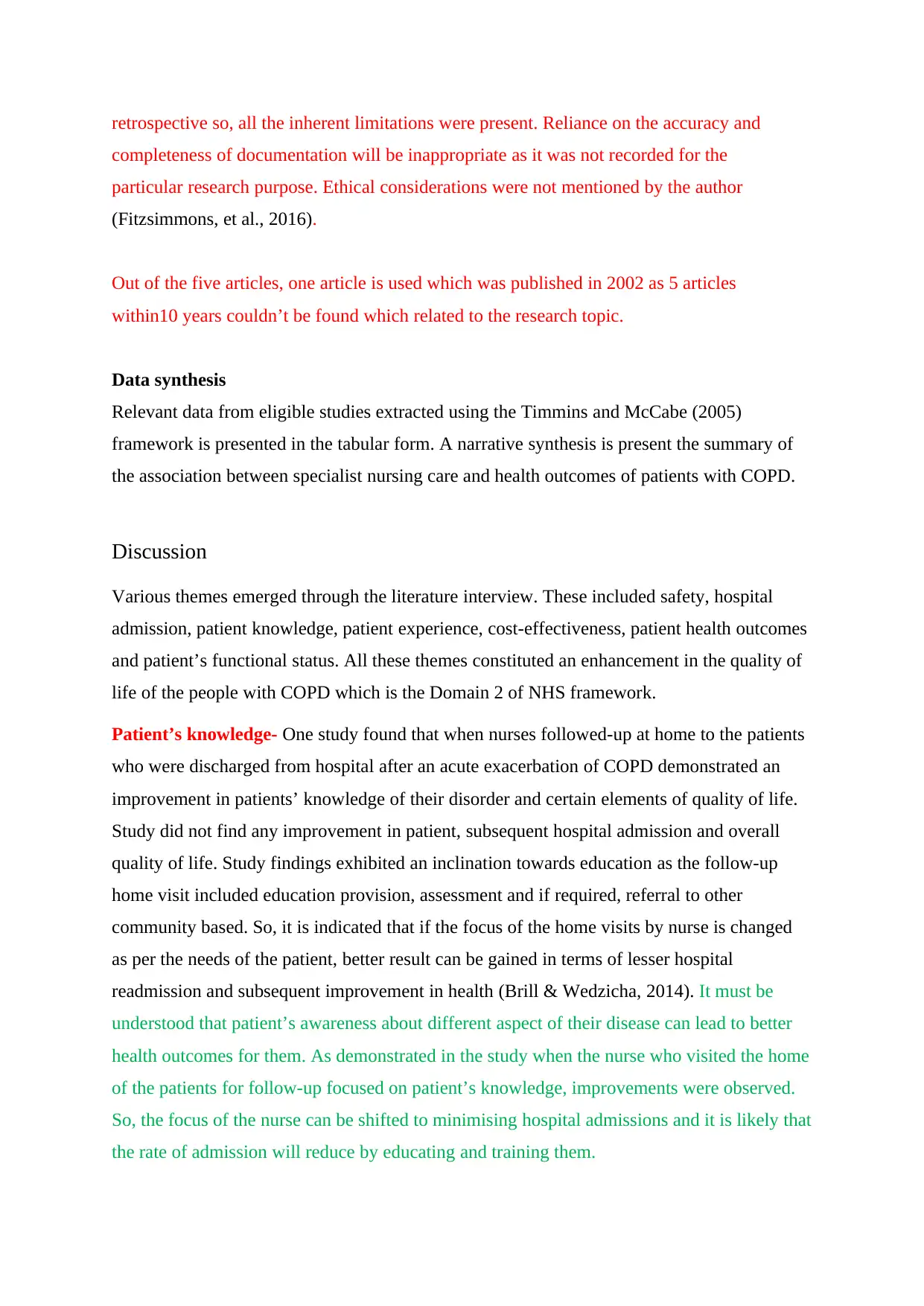
retrospective so, all the inherent limitations were present. Reliance on the accuracy and
completeness of documentation will be inappropriate as it was not recorded for the
particular research purpose. Ethical considerations were not mentioned by the author
(Fitzsimmons, et al., 2016).
Out of the five articles, one article is used which was published in 2002 as 5 articles
within10 years couldn’t be found which related to the research topic.
Data synthesis
Relevant data from eligible studies extracted using the Timmins and McCabe (2005)
framework is presented in the tabular form. A narrative synthesis is present the summary of
the association between specialist nursing care and health outcomes of patients with COPD.
Discussion
Various themes emerged through the literature interview. These included safety, hospital
admission, patient knowledge, patient experience, cost-effectiveness, patient health outcomes
and patient’s functional status. All these themes constituted an enhancement in the quality of
life of the people with COPD which is the Domain 2 of NHS framework.
Patient’s knowledge- One study found that when nurses followed-up at home to the patients
who were discharged from hospital after an acute exacerbation of COPD demonstrated an
improvement in patients’ knowledge of their disorder and certain elements of quality of life.
Study did not find any improvement in patient, subsequent hospital admission and overall
quality of life. Study findings exhibited an inclination towards education as the follow-up
home visit included education provision, assessment and if required, referral to other
community based. So, it is indicated that if the focus of the home visits by nurse is changed
as per the needs of the patient, better result can be gained in terms of lesser hospital
readmission and subsequent improvement in health (Brill & Wedzicha, 2014). It must be
understood that patient’s awareness about different aspect of their disease can lead to better
health outcomes for them. As demonstrated in the study when the nurse who visited the home
of the patients for follow-up focused on patient’s knowledge, improvements were observed.
So, the focus of the nurse can be shifted to minimising hospital admissions and it is likely that
the rate of admission will reduce by educating and training them.
completeness of documentation will be inappropriate as it was not recorded for the
particular research purpose. Ethical considerations were not mentioned by the author
(Fitzsimmons, et al., 2016).
Out of the five articles, one article is used which was published in 2002 as 5 articles
within10 years couldn’t be found which related to the research topic.
Data synthesis
Relevant data from eligible studies extracted using the Timmins and McCabe (2005)
framework is presented in the tabular form. A narrative synthesis is present the summary of
the association between specialist nursing care and health outcomes of patients with COPD.
Discussion
Various themes emerged through the literature interview. These included safety, hospital
admission, patient knowledge, patient experience, cost-effectiveness, patient health outcomes
and patient’s functional status. All these themes constituted an enhancement in the quality of
life of the people with COPD which is the Domain 2 of NHS framework.
Patient’s knowledge- One study found that when nurses followed-up at home to the patients
who were discharged from hospital after an acute exacerbation of COPD demonstrated an
improvement in patients’ knowledge of their disorder and certain elements of quality of life.
Study did not find any improvement in patient, subsequent hospital admission and overall
quality of life. Study findings exhibited an inclination towards education as the follow-up
home visit included education provision, assessment and if required, referral to other
community based. So, it is indicated that if the focus of the home visits by nurse is changed
as per the needs of the patient, better result can be gained in terms of lesser hospital
readmission and subsequent improvement in health (Brill & Wedzicha, 2014). It must be
understood that patient’s awareness about different aspect of their disease can lead to better
health outcomes for them. As demonstrated in the study when the nurse who visited the home
of the patients for follow-up focused on patient’s knowledge, improvements were observed.
So, the focus of the nurse can be shifted to minimising hospital admissions and it is likely that
the rate of admission will reduce by educating and training them.
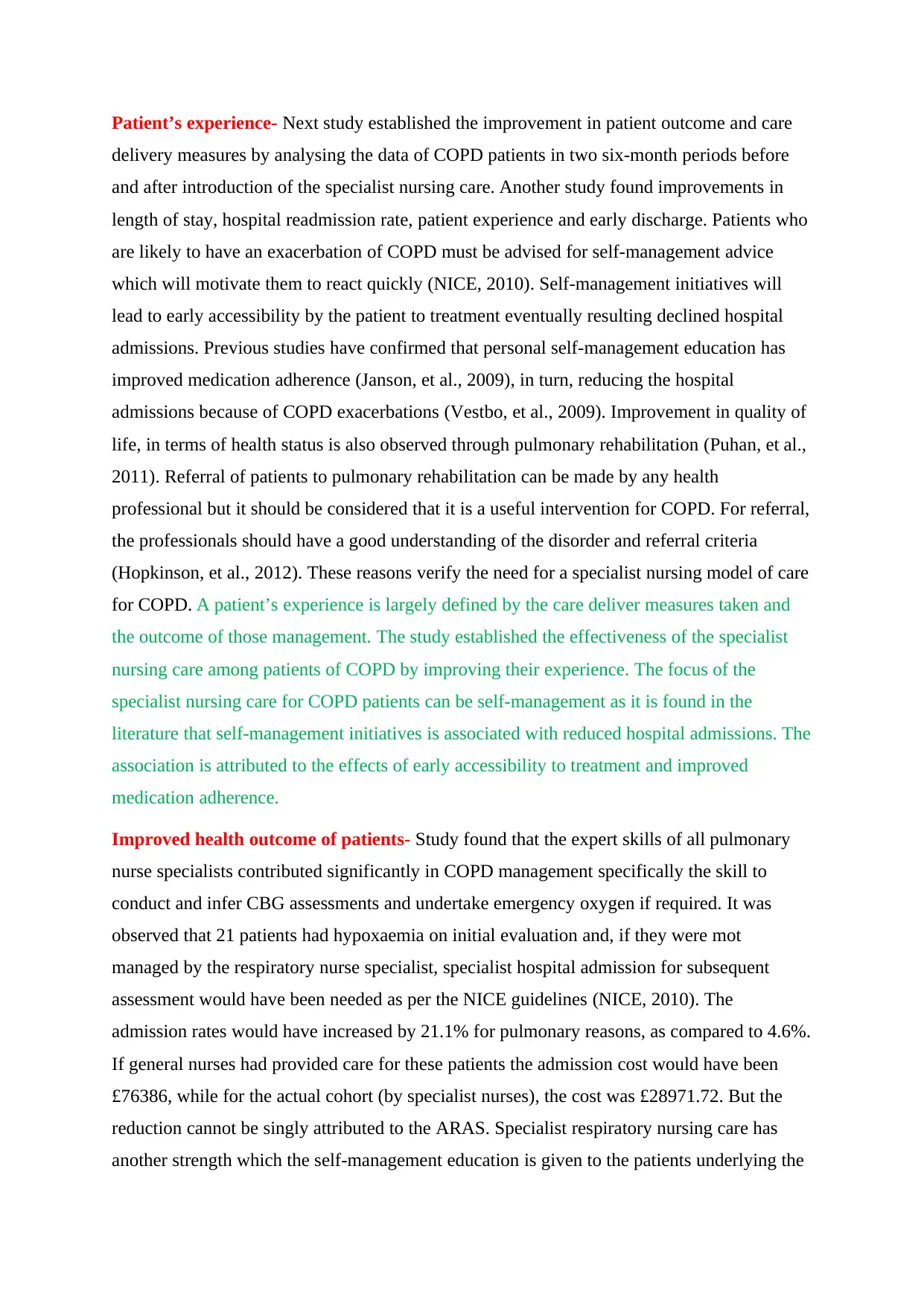
Patient’s experience- Next study established the improvement in patient outcome and care
delivery measures by analysing the data of COPD patients in two six-month periods before
and after introduction of the specialist nursing care. Another study found improvements in
length of stay, hospital readmission rate, patient experience and early discharge. Patients who
are likely to have an exacerbation of COPD must be advised for self-management advice
which will motivate them to react quickly (NICE, 2010). Self-management initiatives will
lead to early accessibility by the patient to treatment eventually resulting declined hospital
admissions. Previous studies have confirmed that personal self-management education has
improved medication adherence (Janson, et al., 2009), in turn, reducing the hospital
admissions because of COPD exacerbations (Vestbo, et al., 2009). Improvement in quality of
life, in terms of health status is also observed through pulmonary rehabilitation (Puhan, et al.,
2011). Referral of patients to pulmonary rehabilitation can be made by any health
professional but it should be considered that it is a useful intervention for COPD. For referral,
the professionals should have a good understanding of the disorder and referral criteria
(Hopkinson, et al., 2012). These reasons verify the need for a specialist nursing model of care
for COPD. A patient’s experience is largely defined by the care deliver measures taken and
the outcome of those management. The study established the effectiveness of the specialist
nursing care among patients of COPD by improving their experience. The focus of the
specialist nursing care for COPD patients can be self-management as it is found in the
literature that self-management initiatives is associated with reduced hospital admissions. The
association is attributed to the effects of early accessibility to treatment and improved
medication adherence.
Improved health outcome of patients- Study found that the expert skills of all pulmonary
nurse specialists contributed significantly in COPD management specifically the skill to
conduct and infer CBG assessments and undertake emergency oxygen if required. It was
observed that 21 patients had hypoxaemia on initial evaluation and, if they were mot
managed by the respiratory nurse specialist, specialist hospital admission for subsequent
assessment would have been needed as per the NICE guidelines (NICE, 2010). The
admission rates would have increased by 21.1% for pulmonary reasons, as compared to 4.6%.
If general nurses had provided care for these patients the admission cost would have been
£76386, while for the actual cohort (by specialist nurses), the cost was £28971.72. But the
reduction cannot be singly attributed to the ARAS. Specialist respiratory nursing care has
another strength which the self-management education is given to the patients underlying the
delivery measures by analysing the data of COPD patients in two six-month periods before
and after introduction of the specialist nursing care. Another study found improvements in
length of stay, hospital readmission rate, patient experience and early discharge. Patients who
are likely to have an exacerbation of COPD must be advised for self-management advice
which will motivate them to react quickly (NICE, 2010). Self-management initiatives will
lead to early accessibility by the patient to treatment eventually resulting declined hospital
admissions. Previous studies have confirmed that personal self-management education has
improved medication adherence (Janson, et al., 2009), in turn, reducing the hospital
admissions because of COPD exacerbations (Vestbo, et al., 2009). Improvement in quality of
life, in terms of health status is also observed through pulmonary rehabilitation (Puhan, et al.,
2011). Referral of patients to pulmonary rehabilitation can be made by any health
professional but it should be considered that it is a useful intervention for COPD. For referral,
the professionals should have a good understanding of the disorder and referral criteria
(Hopkinson, et al., 2012). These reasons verify the need for a specialist nursing model of care
for COPD. A patient’s experience is largely defined by the care deliver measures taken and
the outcome of those management. The study established the effectiveness of the specialist
nursing care among patients of COPD by improving their experience. The focus of the
specialist nursing care for COPD patients can be self-management as it is found in the
literature that self-management initiatives is associated with reduced hospital admissions. The
association is attributed to the effects of early accessibility to treatment and improved
medication adherence.
Improved health outcome of patients- Study found that the expert skills of all pulmonary
nurse specialists contributed significantly in COPD management specifically the skill to
conduct and infer CBG assessments and undertake emergency oxygen if required. It was
observed that 21 patients had hypoxaemia on initial evaluation and, if they were mot
managed by the respiratory nurse specialist, specialist hospital admission for subsequent
assessment would have been needed as per the NICE guidelines (NICE, 2010). The
admission rates would have increased by 21.1% for pulmonary reasons, as compared to 4.6%.
If general nurses had provided care for these patients the admission cost would have been
£76386, while for the actual cohort (by specialist nurses), the cost was £28971.72. But the
reduction cannot be singly attributed to the ARAS. Specialist respiratory nursing care has
another strength which the self-management education is given to the patients underlying the
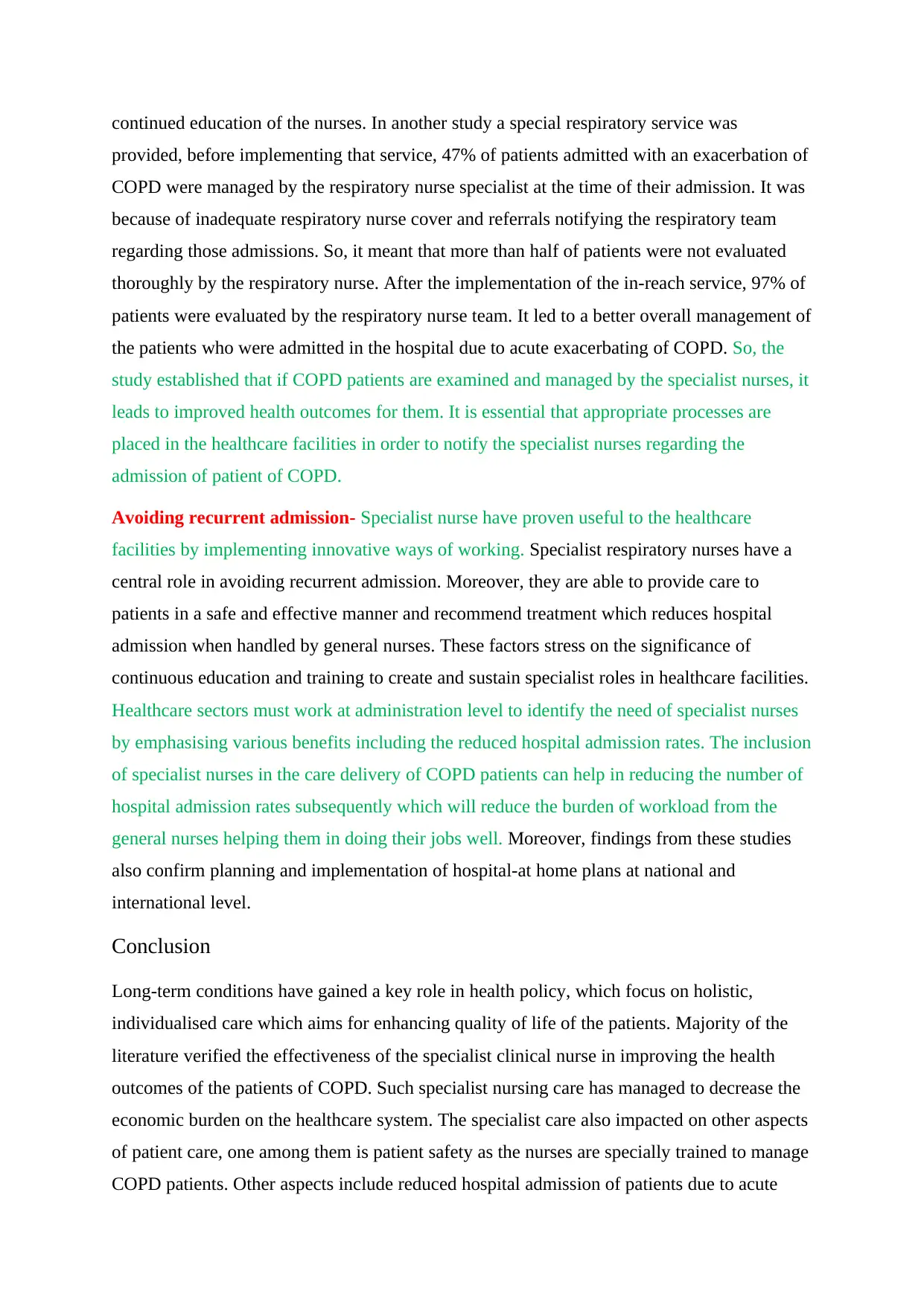
continued education of the nurses. In another study a special respiratory service was
provided, before implementing that service, 47% of patients admitted with an exacerbation of
COPD were managed by the respiratory nurse specialist at the time of their admission. It was
because of inadequate respiratory nurse cover and referrals notifying the respiratory team
regarding those admissions. So, it meant that more than half of patients were not evaluated
thoroughly by the respiratory nurse. After the implementation of the in-reach service, 97% of
patients were evaluated by the respiratory nurse team. It led to a better overall management of
the patients who were admitted in the hospital due to acute exacerbating of COPD. So, the
study established that if COPD patients are examined and managed by the specialist nurses, it
leads to improved health outcomes for them. It is essential that appropriate processes are
placed in the healthcare facilities in order to notify the specialist nurses regarding the
admission of patient of COPD.
Avoiding recurrent admission- Specialist nurse have proven useful to the healthcare
facilities by implementing innovative ways of working. Specialist respiratory nurses have a
central role in avoiding recurrent admission. Moreover, they are able to provide care to
patients in a safe and effective manner and recommend treatment which reduces hospital
admission when handled by general nurses. These factors stress on the significance of
continuous education and training to create and sustain specialist roles in healthcare facilities.
Healthcare sectors must work at administration level to identify the need of specialist nurses
by emphasising various benefits including the reduced hospital admission rates. The inclusion
of specialist nurses in the care delivery of COPD patients can help in reducing the number of
hospital admission rates subsequently which will reduce the burden of workload from the
general nurses helping them in doing their jobs well. Moreover, findings from these studies
also confirm planning and implementation of hospital-at home plans at national and
international level.
Conclusion
Long-term conditions have gained a key role in health policy, which focus on holistic,
individualised care which aims for enhancing quality of life of the patients. Majority of the
literature verified the effectiveness of the specialist clinical nurse in improving the health
outcomes of the patients of COPD. Such specialist nursing care has managed to decrease the
economic burden on the healthcare system. The specialist care also impacted on other aspects
of patient care, one among them is patient safety as the nurses are specially trained to manage
COPD patients. Other aspects include reduced hospital admission of patients due to acute
provided, before implementing that service, 47% of patients admitted with an exacerbation of
COPD were managed by the respiratory nurse specialist at the time of their admission. It was
because of inadequate respiratory nurse cover and referrals notifying the respiratory team
regarding those admissions. So, it meant that more than half of patients were not evaluated
thoroughly by the respiratory nurse. After the implementation of the in-reach service, 97% of
patients were evaluated by the respiratory nurse team. It led to a better overall management of
the patients who were admitted in the hospital due to acute exacerbating of COPD. So, the
study established that if COPD patients are examined and managed by the specialist nurses, it
leads to improved health outcomes for them. It is essential that appropriate processes are
placed in the healthcare facilities in order to notify the specialist nurses regarding the
admission of patient of COPD.
Avoiding recurrent admission- Specialist nurse have proven useful to the healthcare
facilities by implementing innovative ways of working. Specialist respiratory nurses have a
central role in avoiding recurrent admission. Moreover, they are able to provide care to
patients in a safe and effective manner and recommend treatment which reduces hospital
admission when handled by general nurses. These factors stress on the significance of
continuous education and training to create and sustain specialist roles in healthcare facilities.
Healthcare sectors must work at administration level to identify the need of specialist nurses
by emphasising various benefits including the reduced hospital admission rates. The inclusion
of specialist nurses in the care delivery of COPD patients can help in reducing the number of
hospital admission rates subsequently which will reduce the burden of workload from the
general nurses helping them in doing their jobs well. Moreover, findings from these studies
also confirm planning and implementation of hospital-at home plans at national and
international level.
Conclusion
Long-term conditions have gained a key role in health policy, which focus on holistic,
individualised care which aims for enhancing quality of life of the patients. Majority of the
literature verified the effectiveness of the specialist clinical nurse in improving the health
outcomes of the patients of COPD. Such specialist nursing care has managed to decrease the
economic burden on the healthcare system. The specialist care also impacted on other aspects
of patient care, one among them is patient safety as the nurses are specially trained to manage
COPD patients. Other aspects include reduced hospital admission of patients due to acute
Paraphrase This Document
Need a fresh take? Get an instant paraphrase of this document with our AI Paraphraser
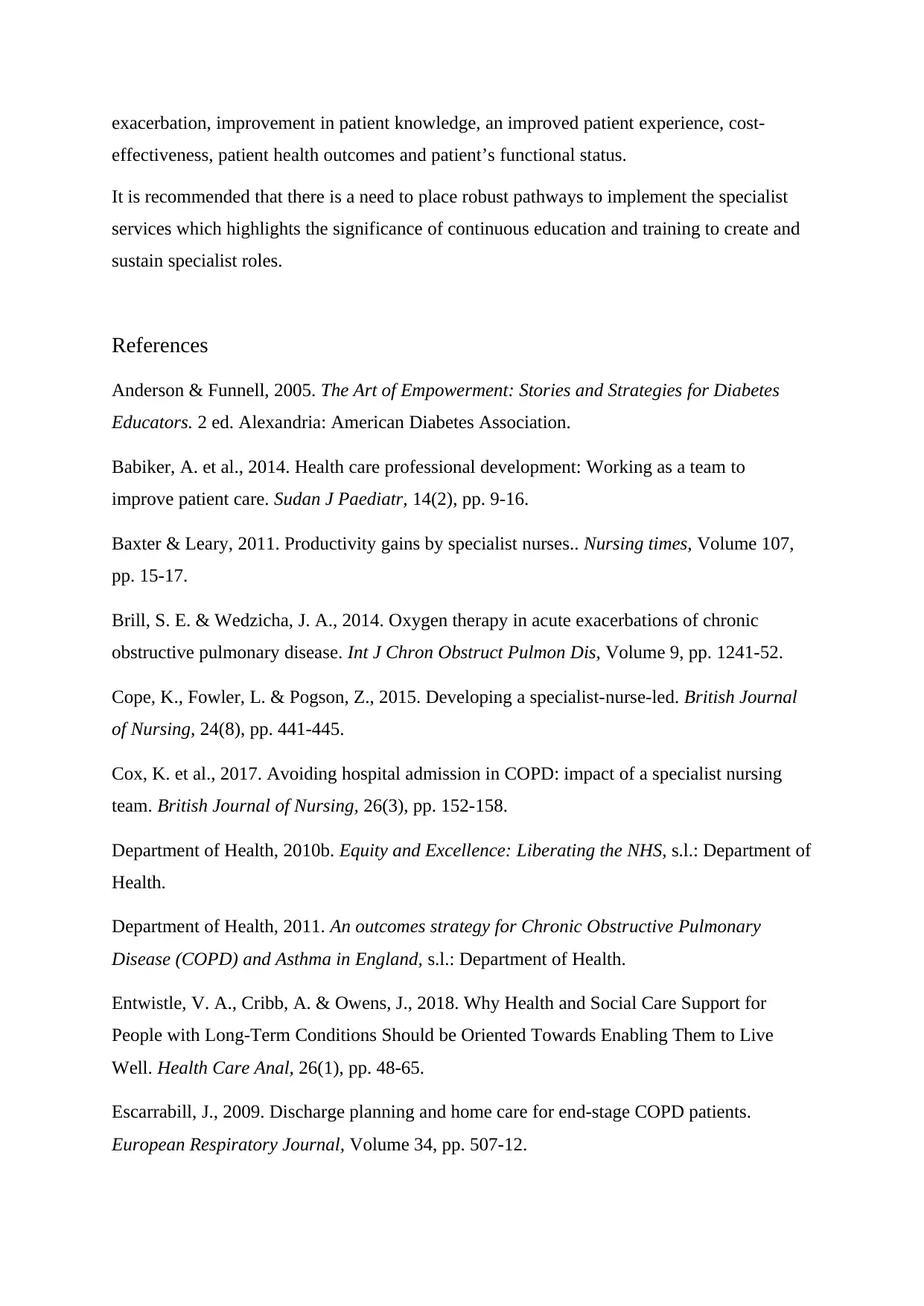
exacerbation, improvement in patient knowledge, an improved patient experience, cost-
effectiveness, patient health outcomes and patient’s functional status.
It is recommended that there is a need to place robust pathways to implement the specialist
services which highlights the significance of continuous education and training to create and
sustain specialist roles.
References
Anderson & Funnell, 2005. The Art of Empowerment: Stories and Strategies for Diabetes
Educators. 2 ed. Alexandria: American Diabetes Association.
Babiker, A. et al., 2014. Health care professional development: Working as a team to
improve patient care. Sudan J Paediatr, 14(2), pp. 9-16.
Baxter & Leary, 2011. Productivity gains by specialist nurses.. Nursing times, Volume 107,
pp. 15-17.
Brill, S. E. & Wedzicha, J. A., 2014. Oxygen therapy in acute exacerbations of chronic
obstructive pulmonary disease. Int J Chron Obstruct Pulmon Dis, Volume 9, pp. 1241-52.
Cope, K., Fowler, L. & Pogson, Z., 2015. Developing a specialist-nurse-led. British Journal
of Nursing, 24(8), pp. 441-445.
Cox, K. et al., 2017. Avoiding hospital admission in COPD: impact of a specialist nursing
team. British Journal of Nursing, 26(3), pp. 152-158.
Department of Health, 2010b. Equity and Excellence: Liberating the NHS, s.l.: Department of
Health.
Department of Health, 2011. An outcomes strategy for Chronic Obstructive Pulmonary
Disease (COPD) and Asthma in England, s.l.: Department of Health.
Entwistle, V. A., Cribb, A. & Owens, J., 2018. Why Health and Social Care Support for
People with Long-Term Conditions Should be Oriented Towards Enabling Them to Live
Well. Health Care Anal, 26(1), pp. 48-65.
Escarrabill, J., 2009. Discharge planning and home care for end-stage COPD patients.
European Respiratory Journal, Volume 34, pp. 507-12.
effectiveness, patient health outcomes and patient’s functional status.
It is recommended that there is a need to place robust pathways to implement the specialist
services which highlights the significance of continuous education and training to create and
sustain specialist roles.
References
Anderson & Funnell, 2005. The Art of Empowerment: Stories and Strategies for Diabetes
Educators. 2 ed. Alexandria: American Diabetes Association.
Babiker, A. et al., 2014. Health care professional development: Working as a team to
improve patient care. Sudan J Paediatr, 14(2), pp. 9-16.
Baxter & Leary, 2011. Productivity gains by specialist nurses.. Nursing times, Volume 107,
pp. 15-17.
Brill, S. E. & Wedzicha, J. A., 2014. Oxygen therapy in acute exacerbations of chronic
obstructive pulmonary disease. Int J Chron Obstruct Pulmon Dis, Volume 9, pp. 1241-52.
Cope, K., Fowler, L. & Pogson, Z., 2015. Developing a specialist-nurse-led. British Journal
of Nursing, 24(8), pp. 441-445.
Cox, K. et al., 2017. Avoiding hospital admission in COPD: impact of a specialist nursing
team. British Journal of Nursing, 26(3), pp. 152-158.
Department of Health, 2010b. Equity and Excellence: Liberating the NHS, s.l.: Department of
Health.
Department of Health, 2011. An outcomes strategy for Chronic Obstructive Pulmonary
Disease (COPD) and Asthma in England, s.l.: Department of Health.
Entwistle, V. A., Cribb, A. & Owens, J., 2018. Why Health and Social Care Support for
People with Long-Term Conditions Should be Oriented Towards Enabling Them to Live
Well. Health Care Anal, 26(1), pp. 48-65.
Escarrabill, J., 2009. Discharge planning and home care for end-stage COPD patients.
European Respiratory Journal, Volume 34, pp. 507-12.
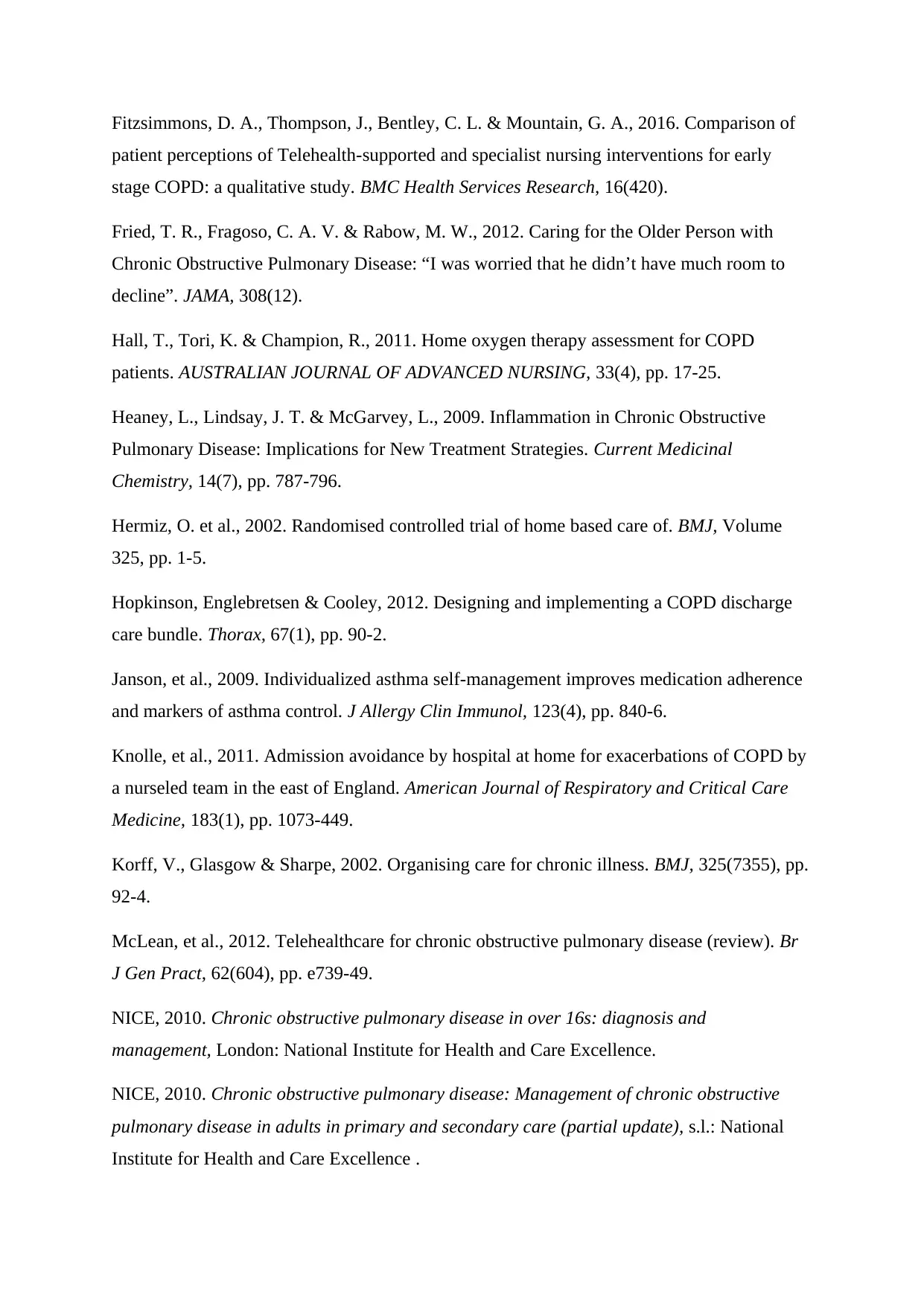
Fitzsimmons, D. A., Thompson, J., Bentley, C. L. & Mountain, G. A., 2016. Comparison of
patient perceptions of Telehealth-supported and specialist nursing interventions for early
stage COPD: a qualitative study. BMC Health Services Research, 16(420).
Fried, T. R., Fragoso, C. A. V. & Rabow, M. W., 2012. Caring for the Older Person with
Chronic Obstructive Pulmonary Disease: “I was worried that he didn’t have much room to
decline”. JAMA, 308(12).
Hall, T., Tori, K. & Champion, R., 2011. Home oxygen therapy assessment for COPD
patients. AUSTRALIAN JOURNAL OF ADVANCED NURSING, 33(4), pp. 17-25.
Heaney, L., Lindsay, J. T. & McGarvey, L., 2009. Inflammation in Chronic Obstructive
Pulmonary Disease: Implications for New Treatment Strategies. Current Medicinal
Chemistry, 14(7), pp. 787-796.
Hermiz, O. et al., 2002. Randomised controlled trial of home based care of. BMJ, Volume
325, pp. 1-5.
Hopkinson, Englebretsen & Cooley, 2012. Designing and implementing a COPD discharge
care bundle. Thorax, 67(1), pp. 90-2.
Janson, et al., 2009. Individualized asthma self-management improves medication adherence
and markers of asthma control. J Allergy Clin Immunol, 123(4), pp. 840-6.
Knolle, et al., 2011. Admission avoidance by hospital at home for exacerbations of COPD by
a nurseled team in the east of England. American Journal of Respiratory and Critical Care
Medicine, 183(1), pp. 1073-449.
Korff, V., Glasgow & Sharpe, 2002. Organising care for chronic illness. BMJ, 325(7355), pp.
92-4.
McLean, et al., 2012. Telehealthcare for chronic obstructive pulmonary disease (review). Br
J Gen Pract, 62(604), pp. e739-49.
NICE, 2010. Chronic obstructive pulmonary disease in over 16s: diagnosis and
management, London: National Institute for Health and Care Excellence.
NICE, 2010. Chronic obstructive pulmonary disease: Management of chronic obstructive
pulmonary disease in adults in primary and secondary care (partial update), s.l.: National
Institute for Health and Care Excellence .
patient perceptions of Telehealth-supported and specialist nursing interventions for early
stage COPD: a qualitative study. BMC Health Services Research, 16(420).
Fried, T. R., Fragoso, C. A. V. & Rabow, M. W., 2012. Caring for the Older Person with
Chronic Obstructive Pulmonary Disease: “I was worried that he didn’t have much room to
decline”. JAMA, 308(12).
Hall, T., Tori, K. & Champion, R., 2011. Home oxygen therapy assessment for COPD
patients. AUSTRALIAN JOURNAL OF ADVANCED NURSING, 33(4), pp. 17-25.
Heaney, L., Lindsay, J. T. & McGarvey, L., 2009. Inflammation in Chronic Obstructive
Pulmonary Disease: Implications for New Treatment Strategies. Current Medicinal
Chemistry, 14(7), pp. 787-796.
Hermiz, O. et al., 2002. Randomised controlled trial of home based care of. BMJ, Volume
325, pp. 1-5.
Hopkinson, Englebretsen & Cooley, 2012. Designing and implementing a COPD discharge
care bundle. Thorax, 67(1), pp. 90-2.
Janson, et al., 2009. Individualized asthma self-management improves medication adherence
and markers of asthma control. J Allergy Clin Immunol, 123(4), pp. 840-6.
Knolle, et al., 2011. Admission avoidance by hospital at home for exacerbations of COPD by
a nurseled team in the east of England. American Journal of Respiratory and Critical Care
Medicine, 183(1), pp. 1073-449.
Korff, V., Glasgow & Sharpe, 2002. Organising care for chronic illness. BMJ, 325(7355), pp.
92-4.
McLean, et al., 2012. Telehealthcare for chronic obstructive pulmonary disease (review). Br
J Gen Pract, 62(604), pp. e739-49.
NICE, 2010. Chronic obstructive pulmonary disease in over 16s: diagnosis and
management, London: National Institute for Health and Care Excellence.
NICE, 2010. Chronic obstructive pulmonary disease: Management of chronic obstructive
pulmonary disease in adults in primary and secondary care (partial update), s.l.: National
Institute for Health and Care Excellence .
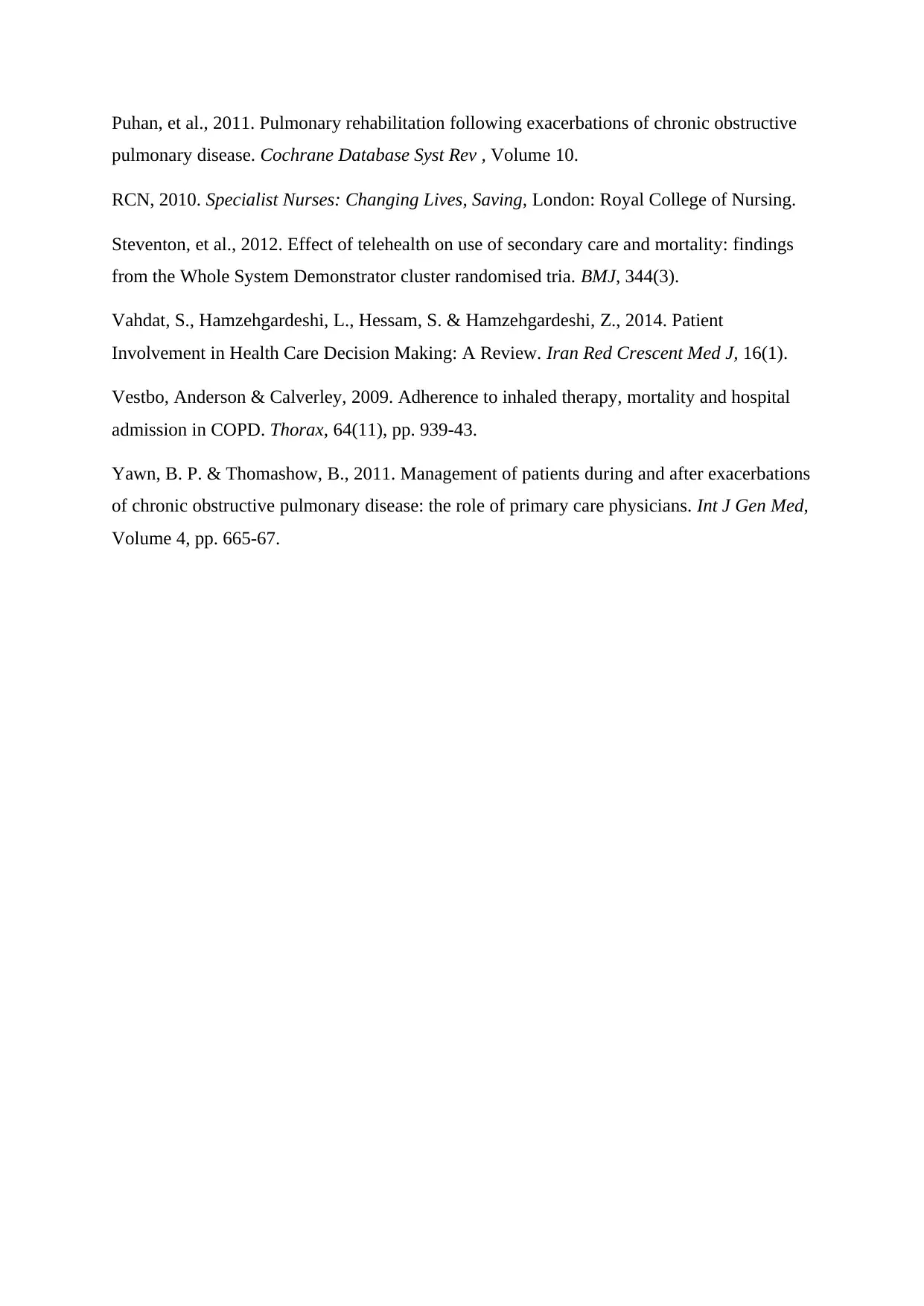
Puhan, et al., 2011. Pulmonary rehabilitation following exacerbations of chronic obstructive
pulmonary disease. Cochrane Database Syst Rev , Volume 10.
RCN, 2010. Specialist Nurses: Changing Lives, Saving, London: Royal College of Nursing.
Steventon, et al., 2012. Effect of telehealth on use of secondary care and mortality: findings
from the Whole System Demonstrator cluster randomised tria. BMJ, 344(3).
Vahdat, S., Hamzehgardeshi, L., Hessam, S. & Hamzehgardeshi, Z., 2014. Patient
Involvement in Health Care Decision Making: A Review. Iran Red Crescent Med J, 16(1).
Vestbo, Anderson & Calverley, 2009. Adherence to inhaled therapy, mortality and hospital
admission in COPD. Thorax, 64(11), pp. 939-43.
Yawn, B. P. & Thomashow, B., 2011. Management of patients during and after exacerbations
of chronic obstructive pulmonary disease: the role of primary care physicians. Int J Gen Med,
Volume 4, pp. 665-67.
pulmonary disease. Cochrane Database Syst Rev , Volume 10.
RCN, 2010. Specialist Nurses: Changing Lives, Saving, London: Royal College of Nursing.
Steventon, et al., 2012. Effect of telehealth on use of secondary care and mortality: findings
from the Whole System Demonstrator cluster randomised tria. BMJ, 344(3).
Vahdat, S., Hamzehgardeshi, L., Hessam, S. & Hamzehgardeshi, Z., 2014. Patient
Involvement in Health Care Decision Making: A Review. Iran Red Crescent Med J, 16(1).
Vestbo, Anderson & Calverley, 2009. Adherence to inhaled therapy, mortality and hospital
admission in COPD. Thorax, 64(11), pp. 939-43.
Yawn, B. P. & Thomashow, B., 2011. Management of patients during and after exacerbations
of chronic obstructive pulmonary disease: the role of primary care physicians. Int J Gen Med,
Volume 4, pp. 665-67.
1 out of 16
Related Documents
Your All-in-One AI-Powered Toolkit for Academic Success.
+13062052269
info@desklib.com
Available 24*7 on WhatsApp / Email
![[object Object]](/_next/static/media/star-bottom.7253800d.svg)
Unlock your academic potential
© 2024 | Zucol Services PVT LTD | All rights reserved.





